After I came home, I was asked the same questions over and over again: Did you make the summit? Did you use oxygen? Would you do it again? And… How did you go to the bathroom? The answer to that last one depends on the phase of the expedition you have in mind, but on the Lhotse Face, the answer is, “Very carefully.” During the night I always peed into my bottle in the sleeping bag, then kept it close by to prevent freezing, and emptied it outside in the morning. But defecation is a different matter… we never do that in the tent. At Camp 3 there was a dedicated latrine area a few meters from the tents. It was just a hole in the snow, not a particularly private or safe spot. I recalled the story of a Taiwanese climber who perished here in 1996 after sliding in his smooth-soled boots down into a crevasse while attempting to relieve himself. The easiest way to avoid such a fate is to just hold it, and wait for the comparatively flat South Col for relief.
I decided that waiting would be a bad idea. As the expedition progressed, we all lost substantial muscle mass… no matter how much we ate, our muscles were consumed for calories preferentially over the fuel in our intestines. This meant not only that we had lots of solid waste to purge, but also that our pelvic muscles had to work even harder to keep it inside. You hear about climbers taking imodium before they summit, just so they will not have to deal with this issue… but, in my experience, it’s better to leave camp without a “round in the chamber,” as Doug Black says.
So, in the middle of the night, I got into my suit, put my boots on, and headed to the latrine. Doing this with oxygen seemed like overkill, so I went without it. I was careful to hold the hand line as if my life depended on it… because it did. It was a stark experience. A cold wind drifted down the Face, making any exposed skin uncomfortable, then painful, then numb within several minutes. From the orb of my headlamp, the sky appeared utterly black. Once I was settled, however, I switched the lamp off and allowed my eyes to adjust. Starlight pierced a broken ceiling of clouds, outlining the ragged ridge running from Lhotse to Nuptse on my left, the monolithic summit block of Everest on my right, and the Cwm thousands of feet below, stretching into the distance.
This is Everest: At once mundane and sublime. By the time I finished my fingers were painfully cold, and I had to be extra careful with my grip of the hand line while heading back to the tents. A teammate arrived just as I was leaving, so focused on the same task that he did not want to chat.
Back in the tent, I found that the condensation lining the inside of my mask had frozen. It’s important to clear the valves of ice before starting the flow again, because this can cause the small rubber diaphragm on the intake port to pop off and fly away under increased pressure from the line. A few hot breaths into the mask melted the ice, and I got back into the rhythm of breathing into the warm, wet rubber, then plugged the red tube into the bottle via a T-splitter, and got my tent mate’s line plugged into the other side. That night we were sharing the bottle at a gentle flow of 1.5 liters per minute split between the two of us, or about 0.75 liters per minute each. Does not sound like much, but our bodies could feel the benefit, even when resting. The difference compared with my last time sleeping at Camp 3 was substantial… no more hallucinations, and a much more humid breathing environment in the mask. I zipped back into the sleeping bag, arranged the tubing and reservoir, and closed my eyes. The soundtrack in my mind:
Sometimes when this place gets kind of empty
The sound of their breath fades with the light
I think about the loveless fascination
Under the milky way tonight
I wish I knew what you were looking for
I might have known what you would find
And there’s something quite peculiar
Something shimmering and white
It leads you here despite your destination
Under the milky way tonight
I listened to the bagpipe chorus in my mind, one of my favorite musical refrains. But, as usual above EBC, I slept poorly. In snippets of 15-30 minutes I would drift off until the prior day’s calls of my teammates to the dead climber shook me awake. In my mind I watched him fall, over and over again, pummeled to death after sailing across the Yellow Band. How could we press on in light of this loss? My rational side made sense of the situation: Many have died here already, and more will probably die in the future. The only difference is that you were close to it yesterday. Stick to your plan, and climb safely. But, my emotional side remained shaken.
I kept a close eye on the clock, and counted down the time until our wake up at 4 AM. Sleep, dammit. You may not get another chance for the next 48 hours. But, no good. My “monkey mind” was chattering away, jabbering about the pain of the days to come, and the risks we were about to take. Shut up and go to sleep, you stupid monkey. I went to a calm place, resting in a hammock with my family on a warm tropical island, drenched in their affection, and breathing in the warm, humid air, with a refreshing breeze rolling in from the surf. This helped… but not for long. The sounds of our Sherpa guides preparing hots in the tent next door woke me, and I disarmed the alarm before it sounded.
I crawled through the vestibule to check the conditions: Everything looked perfect. Clear sky, mild katabatic winds, a dimly lit frozen blue world. The summit was right there, dark rock against the pale dawn, a small plume ripping majestically towards Tibet. And I thought, Bring it.
Julie. I wanted her to hear that all was good with me, especially after the previous day’s tragedy. My text to her: “Hi. Slept well. Busy getting ready to move to C4. Weather good. Should get there around noon. Love you so much.”
Julie: “How soon until you leave?”
Me: “5:30. 1:15 to go.”
Julie: “Thinking of you nonstop.”
Me: “Thx love. Same here.”
While I prepared for the day, I focused on the words of my friend Jason, who had summited successfully in 2010. He was a huge help to me during the expedition, serving as a coach and mentor… and a kind of court jester. His text messages always made me smile. Several days earlier he had pinged me on the InReach: “Just two more hard days again P2. I know you can do it!! The SUMMIT is very worth all the suffering you are dealing with. [Camp] 3 to 4 is a rest day in your pocket.” I held onto those words, “a rest day in your pocket,” like a crutch. Today won’t be that bad.
Pasang Kami visited us at 5:00 and provided warm water. It was not the piping hot chu to which we were accustomed, but it would be just fine. Breakfast did not have to be my usual hot oatmeal… instead, one and a half snickers bars, a fistful of smoked almonds, and several dried mango strips would do nicely. My main concern was that the water would freeze up high. I had brought a 1.2 liter steel HydroFlask thermos, two 500 ml plastic Nalgene bottles, and the heavy-duty insulated CamelBak. On this day, I would fill the HydroFlask and the CamelBak… to save weight, the Nalgenes would remain empty. I knew that if it went in scorching hot, the water would stay liquid in the Flask for at least six hours (if kept insulated in my pack), but the CamelBak would freeze much sooner unless it went in steaming, even if I wore it under the down suit, next to my base layer. No worries, just drink the CamelBak first. Taking a hydration system like this up high went against my training and experience. Real mountaineers never use hydration systems in the high wilderness, where they are just unreliable. But it had worked so well up to now, even on the freezing cold Face the prior day. I knew that if I blew air back into the line after drinking, there would be no water in there to freeze. Dealing with the mask was going to be a hassle, and being able to sip water from the long tube any time I wanted—not just at rest stops—seemed to outweigh the risk of the system freezing. Besides, dropping in some electrolyte powder that Justin had lent me would depress the freezing point a bit. I was obsessed with water on this rotation, and envisioned the consequences of dehydration: thickened blood leading to a deep vein thrombosis in my leg, a pulmonary embolism, a heart attack, or a stroke. You will drink plenty today. This will be fine.
Mornings are always a frenzy of activity on the mountain, and this was no different. There was not much to organize, because almost everything was headed up the mountain with us. Only my helmet, lightweight climbing gloves, and some snack food would remain behind at Camp 3, where I would pick them up on the way down. I got my kit together on time, although it felt like hard work, especially stuffing my -40 degree sleeping bag into its compression sack. For the second time this trip, the sack had sustained a crampon wound and begun to split. I had replaced the first sack, which ended up torn to ribbons during the prior rotation. And now, the replacement was shot, too. It had not been my crampon… but, whomever had stepped on the bag, it mattered not. I was not angry, just frustrated because the tear would enlarge with every thrust I made into the sack. I did not want the bag to start flapping in the breeze when Pasang Kami strapped it heroically to the outside of his own pack. Yes, once again our Sherpa guides had offered to carry our sleeping bags and pads to the South Col. In fact, these items were almost always hauled by them during the expedition. This was more than kindness, and more than their paid duty… it was the only way we would have a shot at the summit, and everyone knew it. Every gram up there makes a difference for us, and so does every cubic centimeter. Volume became a real concern that day, because we had new guests in our packs: Oxygen cylinders.
We were trained to use IMG’s oxygen system, and things had gone well that night while we slept on the bottles. But now it was time to climb with them. The cylinders had been hauled up the mountain by our Sherpa teammates, painstakingly, in the previous days. Now, bottles were stockpiled at Camp 3 and Camp 4, and it was our job to use them.
Everyone on the mountain uses the same cylinders, manufactured by a Russian company called Poisk. Except for us. Some years ago Eric Simonson pioneered the use of a different bottle which holds about three times as much gas as the Poisk bottles. To keep them light, they are made of ultra-thin aluminum, reinforced with a mesh of tightly-woven fiberglass fabric. We are proud to carry these cylinders, because they provide an additional measure of safety, and cannot easily be used by other mountaineers (whether desperate or unscrupulous) because ours require different regulators. But… man, are they bulky. The bottle was the last thing for me to pack, and I was stunned to realize that my pack was already quite full even before I added the bottle, which seemed to require about one third of the pack volume. How am I going to do this? I looked at my tent mate, who was a bit behind me in the packing process, but also quite daunted by what he was seeing. Seriously, how in the hell am I going to do this? In the end, of course, I was able to cram in everything that I needed. But it really was tight.
As I hauled the pack to the vestibule, I realized that it weighed much more than I had bargained for. About 17 pounds more. At sea level, this amount of weight is trivial. Up high, however, it is a different story. The tradeoff is clear: For the increased weight of the compressed gas, we get a substantial boost in performance—and safety. The benefits are worth the investment of pain. We knew this moment of reckoning would come. But oh my god this thing weighs a ton. No matter. It was time to strap in and get moving, in a pack that was substantially heavier than any I had worn all expedition.
Will you be strong enough? Let’s find out.
But first, get into your harness, boots, and crampons.
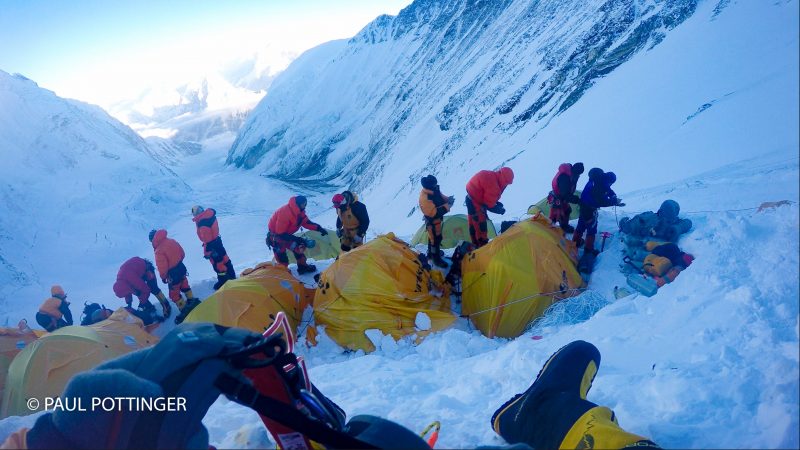
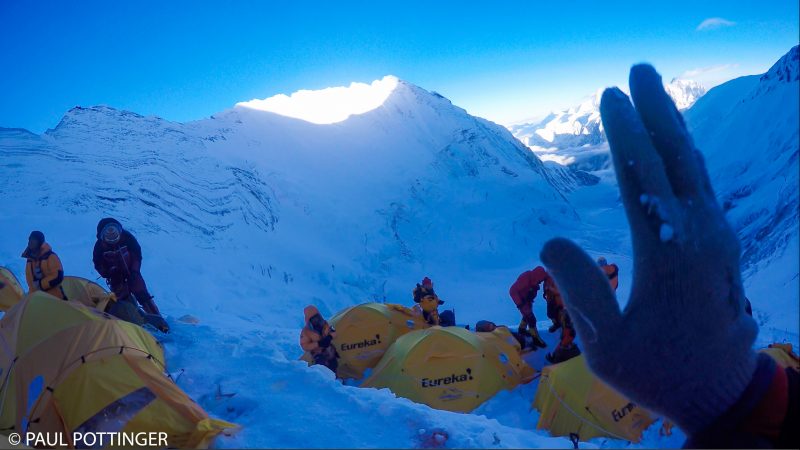
Putting on these last items was always a chore. And that day I moved more slowly than usual, even with supplemental O2 flowing. I donned the Olympus Mons boots in the tent, wearing my merino liner gloves. The issue here is that the boot velcro tends to stick to the gloves, ripping their fingertips out… something I did not want to happen just before summit day. With care, I got them on, then moved outside and sat in the vestibule. Camp 3 bustled with activity. I saw Kim standing in front of her tent on the platform below mine, and we waved, my first contact with Team Hybrid since the prior afternoon. My buddies and guides had camped one tier below me, and we had only chatted briefly when I went down for a visit after the tragedy. So, I was a bit out of touch with them this morning… based on everyone’s state of dress, I realized that I was behind: the others were already wearing their harnesses and crampons. They would leave any minute. Focus, and get ready. For some reason, I took several minutes to put on my harness… it just wouldn’t come untangled from the frozen mess it had become overnight in the vestibule. Looking back at my video footage of this now, it’s clear that my thinking and coordination were not normal that morning.
While checking the fit and rigging of my harness, I did have the presence of mind to recite the mantra I say every time I put it on, in memory of the loss of my hero on the other side of the mountain all those years ago: “No more Marty Hoeys, God rest her hot amazing soul.” Marty made a mistake with her harness, and she paid for it with her life. No mistakes today.
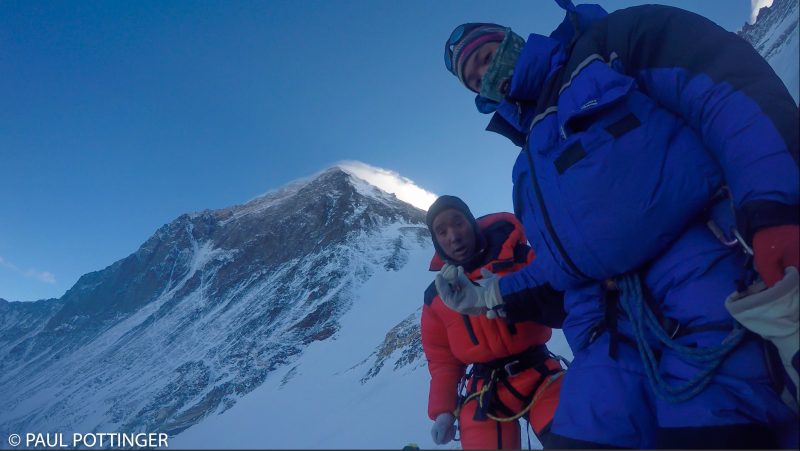
While I was preparing to go, Pasang Kami and Sherpa Fura came to check on my progress. Fura served as an interpreter for Pasang—something we had never done before—to make it totally clear that he was eager to haul more of my gear that day. Not only the sleeping bag and pad, but anything else I wanted to give him. This was totally unexpected, and amazing… and also a bit rattling, as it implied that he felt my performance had not been fast enough the prior day. At least, that’s how I interpreted it. But I did not care. This was a kind of godsend, given the weight of my pack. I gave him my full HydroFlask, saving me over a kilogram of weight. “Yes, OK,” he said. “What else?”
There were so many tempting items in my pack to hand over: the extra batteries, the summit mitts, the backup down sweater…. all tempting to give him. But I did not want to do that. He is mortal, too, and would be fighting up there like the rest of us. Although I was weak and fragile compared with my Sherpa guide, I still had my pride, and I still wanted to do this with some shred of independence and dignity, maybe a modicum of style. “Nothing else Ang Kami. I’m good.”
“Nothing?” They both looked surprised and a bit concerned.
“No thank you, I’m good.”
I looked back into the tent one more time, to be sure I had not forgotten anything. All that remained behind was the O2 cylinder we had shared that night, with my regulator still attached. The bottle Josh McDowell had delivered earlier already had a regulator attached, so no need to bring a second one. I dialed in 3 liters per minute on the regulator, got the mask on, and hoisted the pack with Pasang Kami’s help. Holy living… so much heavier today. Breathe. You can do it. I buckled the hip belt by feel (it was impossible to see while wearing my mask and the bulky down suit). I made sure that the USB cable ran more or less out of my field of view between the GoPro on my head strap and the auxiliary battery in my suit, not too tight to limit my range of motion, but not too slack so that it flopped forward and bugged me. It did anyway, but not too badly.
Standing on the catwalk in front of the tent, I realized that only Siva and I remained in camp; our teammates had already departed. Two IMG guides would sweep the rear that day, Josh McDowell and Emily Johnston. Emily was working with Siva on the lower platform, so Josh and I would start out together. I was glad to have this opportunity to climb with Josh. We had climbed Aconcagua together in 2013, where he kept us smiling and laughing the whole way. After I saw him save a team during a real-deal whiteout on summit day, I came to admire him greatly. Like all IMG guides, he had what it took to keep us happy and safe. In fact, he is one of my favorite people. This time, Josh had been guiding a different sub-group for most of the expedition, so climbing with him was a fun aspect to the day. I asked him to confirm that my GoPro was recording, and he gave me a thumbs up. And we were off.
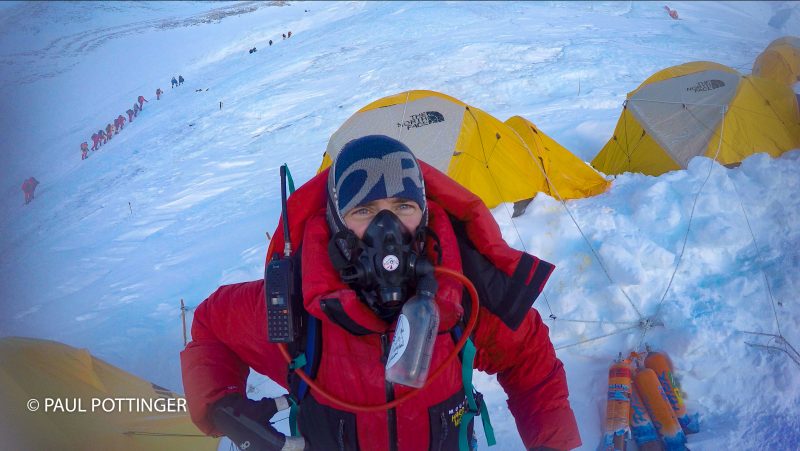
Pasang Kami led the way, stepping down to the hand line that ran to the latrine and climbing route above that. I had grasped the line many times in the prior day, but somehow this was different: I felt awkward, heavy, unbalanced, and slow. To compensate, I clipped into the hand line with my safety carabiner. Pasang Kami immediately started walking towards the main climbing line. Not rest-stepping, just walking at a normal pace, as if we were on a sidewalk in New York City. Justin was about 20 meters ahead of him, and Pasang Kami clearly wanted to catch up. The rest of the team was lined up in a tight column, almost at a standstill, below the great bulge of blue ice that loomed above… two Sherpa climbers from another team were on the main line below us, but they would not get in the way… so there was no rush to catch up. I repeated Emily Johnston’s exhortation to me from the day before: Move at your own pace, not the Sherpas’. This is no sprint.
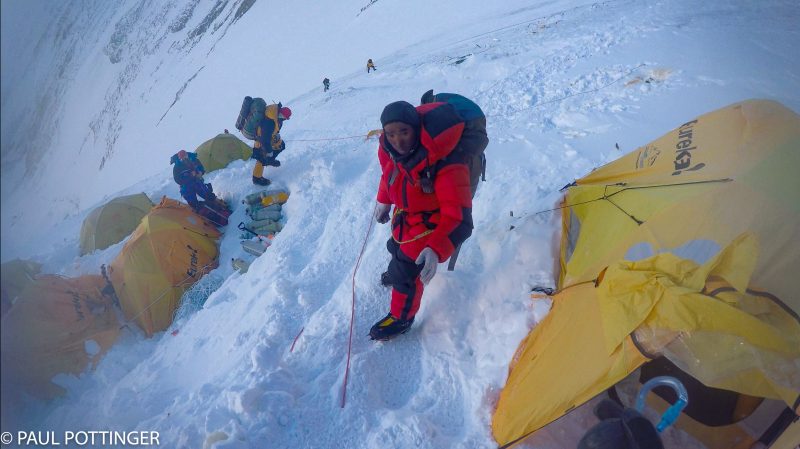
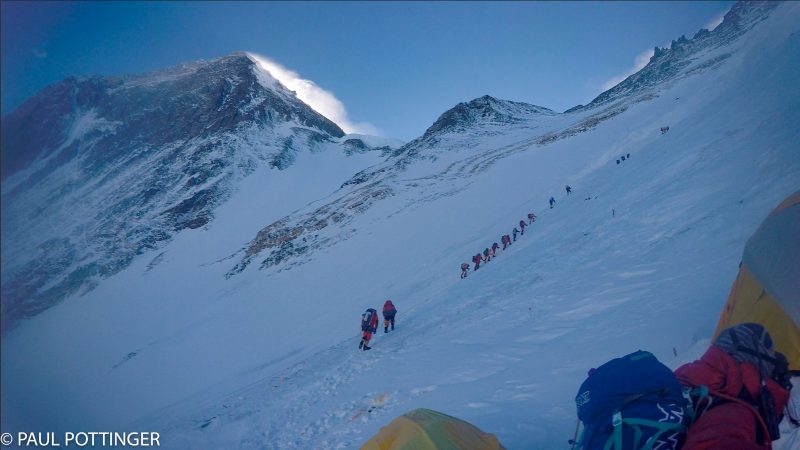
A minute later, the detritus of camp was behind us, including the toilet pit and the aluminum snow pickets from prior years, which were twisted and bent at obscene angles under the weight of successive avalanches. The hand line ended at a snow anchor about a meter below the climbing line. As I bent forward to unclip from the hand line, I found that I could not reach the main climbing line at the same time: I would have to unclip and take a step up unprotected. Here, the angle of the Face was not too severe, and Pasang Kami was there to assist. I took the step and clipped into the climbing rope, no problem. And I said to myself, consciously, You will not do that again today. Not even once.
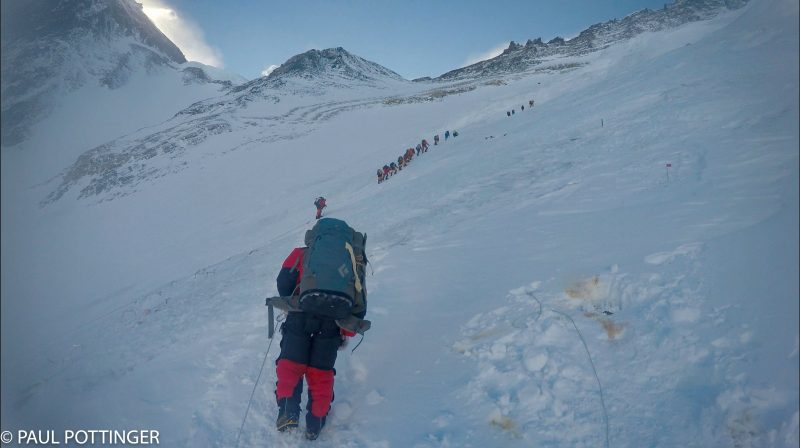
I looked up at the route: The column of my friends lined up below the steep ice bulge… the mustard-colored rocks of the Yellow Band above… the dark stone of Lhotse outlined sharply against a seamless pale sky. Breathe. Remember this. Take it with you until you die. Everything from here forward will be new.
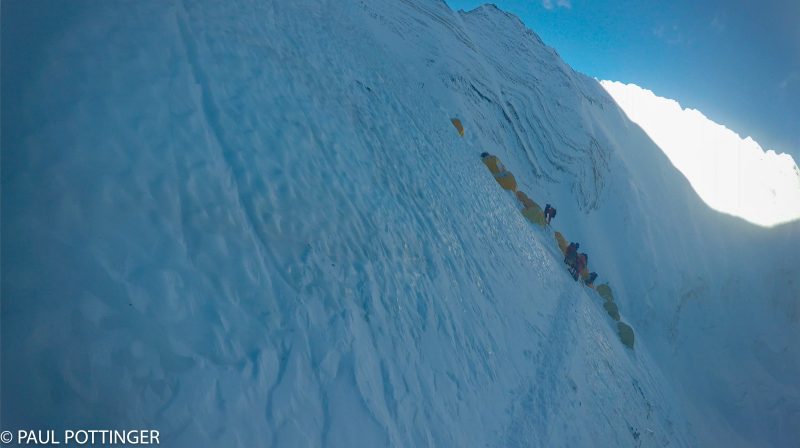
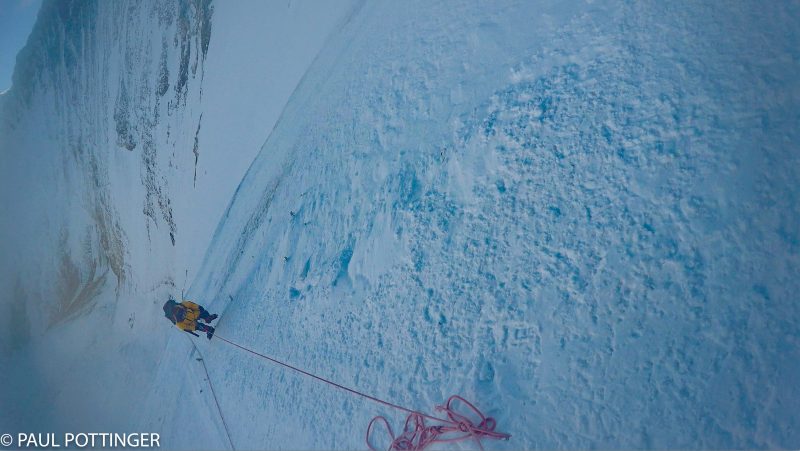
I had envisioned this part of the climb every day for the last year. I had dreamed of this section. And now, I was climbing into that dreamscape. I wanted to step to the beat of a metronome pulsating from deep beneath the mountain… to kick my feet into the ice and send reverberations out into the master plan of the universe… to savor each moment as a fulfillment of my lifetime’s ambition.
Instead, the work of climbing consumed me. I looked for my rhythm but had a tough time finding it. So many systems competed for my attention in those initial minutes. The homemade shoulder straps for the CamelBak continuously slipped down over my left deltoid—always the left, although I have no idea why—and that restrictive feeling across my left biceps drove me crazy. My oxygen mask leaked a bit around my nose, which was not a major problem, but worried me for fogging potential later in the morning when I would wear goggles. The GoPro tended to slide to one side or another on my elastic head strap. The USB power cable would slip out of position and into my field of vision, and when I tried to tuck it into my suit it felt too tight. The auxiliary battery switched off automatically after a certain period of time—not sure what period of time, but perhaps 5 minutes—so that every time I wanted to shoot I had to first pull it out of my down suit’s inner chest pocket and look at the indicator lights to ensure it was on, then fire up the GoPro by squeezing the power button and listening intensely for the three beeps. With the camera in its lexan housing, and with the windstopper fleece balaclava on, I could hardly hear the little beeps. Without anyone behind me, the rope fell slack above the last anchor, so that I had to pull it taught with my left hand behind the ascender, which is awkward and exhausting. Slack lines are perfect for descending, but a drag on the way up.
I was so grateful for Justin’s recommendation to climb without a helmet: it would have been just one more source of distraction and aggravation.
Breathing is always the top concern up high: no matter how I try to hyperventilate before we get started, I always feel winded in those first minutes on steep terrain… even at 3 liters per minute from the bottle. I focused on Holly Drummond’s lyrics like a mantra of pain:
Do you suck the life from me?
Make it hard just to breathe?
No, I won’t be a fool
I won’t play by your rules
You can’t keep your hold on me
In and out… breaking free
Breathe in… breathe out
You are suffocating me…
Breathe in… breathe out
Set me free….
My biggest concern in those first minutes was temperature: I was absolutely burning up. I wore my favorite Patagonia long sleeve quarter-zip T shirt, then a lightweight Ibex merino hoodie. On my legs, a pair of Ibex merino briefs, then two pair of medium weight long underwear (one merino, one synthetic). And the down suit. Even in the deep shadow of Lhotse, with all my zippers open, I felt my core temperature shoot up. I tried to climb slowly to generate less heat, which I knew would help eventually. But the route was steep right out of the gate as we headed up to the first ice bulge. I wanted to catch the main group, and to prevent the climbers below from overtaking me. I knew that my breathing would settle, and that my oxygen hunger would subside, as my heart rate rose to a new equilibrium. This happens every time you start out on steep terrain. Don’t panic. Just take it easy. Breathe. I sipped warm water from my CamelBak hose.
But it was no use. I would overheat if I did not make a change. I wanted to tell Pasang Kami, and to have his help with the transition, but he was too far ahead to hear me shout through the mask. I stopped and struggled out of the suit sleeves, taking the pack off one shoulder at a time, then stuffing the sleeves behind me. My sweat-soaked arms felt better right away, and for a short time I was able to climb more comfortably. I would not need to get those sleeves on again until we were above the bulge.
We approached the bulge in lockstep, a tight team stepping in the bootprints of our predecessors, like climbing a long set of stairs. The feature had looked intimidating from Camp 3, but as often happens it was perfectly fine once I actually started climbing it. My breathing settled… my core temp fell back towards normal… my hands felt good… my feet were perfect. This is what climbing Everest is all about.
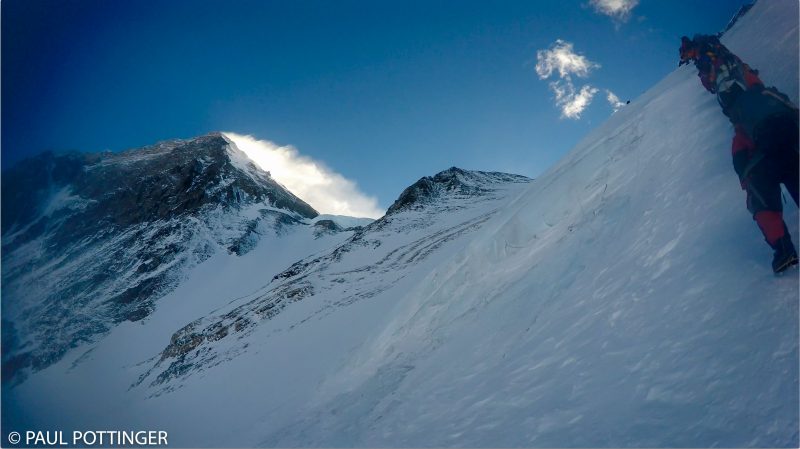

I shot footage of the column as it made its way up the bulge, and gave Justin a thumbs up: All was well. I looked back over my shoulder at the Cwm, stretching down towards EBC, under a flawless blue sky. Siva was transitioning at the anchor below me, and I gave him a thumbs up, too, then turned to face the route again, and turned the camera off. Some of my teammates had already topped out on the bulge and stepped out of view.
Moments later, a shocking sight: a climber appeared from over the top of the bulge, flying through the air and down the Face several meters to our left. He was in a seated position, feet forward, reminiscent of someone trying to glissade on purpose. But this was no glissade. He fell to the ice like a rag doll thrown by an angry giant. After sliding for a moment he hit another bump and became airborne again, then slammed down onto the ice once more, his head whipping violently to the side, crushed against the frozen ground. I struggled to understand who this was, as I did not recognize him immediately under his red suit, white hat, and black rubber mask. In an instant he rocketed past me, well out of reach by several meters, but so tantalizingly close.
Although the whole fall lasted only several seconds, my perception of time slowed down as he passed by. This is an effect of adrenaline. I once heard an interview with a fighter pilot who recounted a dogfight during the Korean war: The MiG he was hunting slid in front of his Sabre, and he automatically started counting the rivets in his opponent’s tailpipe… I think he got to 11 before realizing that his finger was only then beginning to obey his brain’s command to squeeze the trigger. Here, in this moment on the Lhotse Face, some details were utterly lost on me, while others seared their way into my memory. The white oval IMG sticker on his oxygen reservoir… the sickening sound of his suit and backpack scraping the ice… the violent thrashing his head took when it hit the Face… these observations will stay with me forever.
He was trying to arrest, struggling to dig his right elbow into the ice, but it bounced off with every bone-jarring bump. I knew, down deep in my core, that this would fail. He was on his back, sliding with an axe strapped uselessly to his pack, on steep solid blue ice.
This was a fatal fall, and I was watching him die.
As he passed by, fast as a luge rider, thoughts stacked up in my mind in a flash: Who is he? How could he have come unclipped? For some reason, the timing of the accident was outrageous to me: We are only a few minutes out of camp… We are only a few minutes out of camp! Dying on summit day was one thing, but this seemed somehow worse, somehow… inexcusable. This is exactly what happened yesterday. NOT AGAIN! Stop! STOP! STOP!!!!!
And then: His family will be devastated. I wished the camera was on to capture this, for them.
Days later, when the team assembled at EBC after the climb, we shared our memories of this moment. Kim’s experience was the worst among the witnesses: Atop the bulge, she saw him slip from the corner of her eye, just next to her. Instinctively, she reached out to grab him… but she could not get a firm grip. His pack’s shoulder strap zipped through her gloved hand… and he disappeared over the ridge. She did not even bother to watch him fall. “I just looked down at my boots. I didn’t want to watch him go, because I knew he was already dead.”
But we were wrong. Within seconds, as he slid towards Camp 3, the ride came to an end. There was just enough of a small rise there, a kind of low crest of snow on the face, to stop his slide. He jolted to a halt, still in a seated position, and propped himself up with his right hand.
In my hypoxic state, heart slamming in my chest, hyperventilating, eyes as wide as saucers, fingers gripping the ascender so tightly that my fingernail beds throbbed for hours afterwards, I thought: That’s a fucking miracle.
Justin descended the line and within seconds was at my side. “Who was that?”
“I don’t know,” I said. “One of our Sherpa. I saw the IMG sticker on his reservoir bottle.”
“If he was wearing a mask, it wasn’t a Sherpa.” This dawned on me slowly. He was right… because our Sherpa were still breathing ambient air at this elevation.
Which meant the fallen climber must be one of the team members….
Someone wearing a red suit… not Kim… not Steven… not Siva… not Nicky… not Bob… which left only…
Cristiano.
That’s Cristiano.
My team mate. My tent mate.
My friend.
I watched him struggle to remain seated. He was clearly in a daze, wrestling with his backpack, trying to remove it while keeping stable.
Emily Johnston and Josh McDowell happened to be near his landing site. From her position clipped to the climbing rope, Emily called out to him, “Cristiano, don’t move!”
“I’m afraid that I will fall if I take off my pack,” he said in a slow, distracted voice.
“DON’T MOVE!” she and I shouted in unison. He was held in place by his crampon points sticking into the ice, and nothing more. The Cwm yawned hungrily, thousands of feet below.
“STAY STILL CRISTIANO!” I yelled into my mask. He seemed to become too tired to struggle, and slumped down a bit into the ice.
Record this. I thought I switched the camera on, only to learn days later that somehow, I had failed to get the shot. I suspect that the auxiliary battery had switched off moments earlier.
Josh fetched the rescue rope from his pack, put Emily on belay, and paid out the line carefully while she walked to Cristiano, perhaps 20 meters away. At one point, the snow broke free from beneath her, and she punched through above her knees.
This was a snow bridge. Cristiano had been stopped by a crevasse, and now it wanted to eat him and Emily for breakfast.
Within moments she had climbed free and continued to him. She put him on belay and started her primary survey.
I turned to Justin. “I’m going down.”
“No. He’s in good hands. I want you moving up.”
“Are you sure? Let me help.”
“He’s in good hands. Emily knows what she is doing.”
“We go up?” asked Pasang Kami. I tried to process the accident. My teammate had just fallen on the Lhotse Face, pummeled against blue ice, and only a miracle had stopped him. I have read lots about Everest, and cannot recall such a fall ending this way. Less than 24 hours earlier the same thing had happened in the exact same spot, with fatal results. My addled, hypoxic brain tried to make sense of the situation… how could it? Cristiano looked okay down there, conscious and sitting up. And Emily is a very experienced mountaineering doctor, the best, no doubt. Josh was there, too, and Cristiano’s climbing Sherpa, Nima Dorje, was headed down to assist. Justin and our teammates were already heading uphill. You would probably just get in the way.
“OK,” I said. “Up.”
It felt wrong to keep going. I desperately wanted to know what was happening down there. I assumed that he would be able to walk down under his own power, or perhaps to spend the night at Camp 3, and try again the next day if all was in order. But what was going on? For the next hour I tried to follow the radio chatter, but it was very difficult… Pasang Kami carried the radio for both of us, and he was always at least a few steps ahead. Plus, it was difficult to understand the conversation from under my fleece balaclava, especially with the sound of my own breathing into the mask. I could often hear a female voice, with what sounded like an American accent… That must be Emily giving report to EBC. I could not understand a word she was saying, but I could hear the optimism in her voice, and a singsong, almost chatty cadence to her sentences. She sounded confident. Everything must be OK. Everyone is still heading up. Everything must be OK.
Somewhere in my mind, partially suppressed, was the question, “What would you have done if he hadn’t stopped?” I pondered this for a moment, and the answer became clear. I watched the scenario play out in my mind: His body being retrieved from the bergschrund… being flown down from Camp 2… being flown home in the belly of a passenger jet… with me on board, accompanying him home, heartbroken, delivering him to his survivors… watching from the window as yet another season slipped by, wasted by tragedy and ruin, grieving for my friend, bitter about the loss of my elusive dream for the second time, happy to be alive, but guilty that I had survived.
Focus, Paul.
Less than an hour after I topped out on the ice bulge, Josh McDowell caught up with me. He reassured me that Cristiano was fine… and that he was climbing up once again. I had assumed he would head down, or at least spend the night in Camp 3 to reassess things. “Really? That is amazing!” I said, shaking my head slowly. I must have misjudged this whole incident.
“I’m sorry to ask,” Josh said with a sheepish look, “but are you clipped in twice?”
I showed him my rig and gestured in a way that said, “Are you serious?”
“I know,” he apologized. “Greg told me to make sure everyone is clipped in twice. You are good.”
I asked how this had happened to Cristiano, and Josh said he did not know. “Just clip twice and you are good.”
Getting back into the sleeves of my down suit had cost me some time, and the column had pulled ahead. Josh was clearly in perfect shape, and wanted to move faster. “I’m going to go ahead, if that’s OK.”
“Absolutely. Rock on.” He stepped smoothly past me and Pasang Kami. That was the last time I would see him until Camp 4.
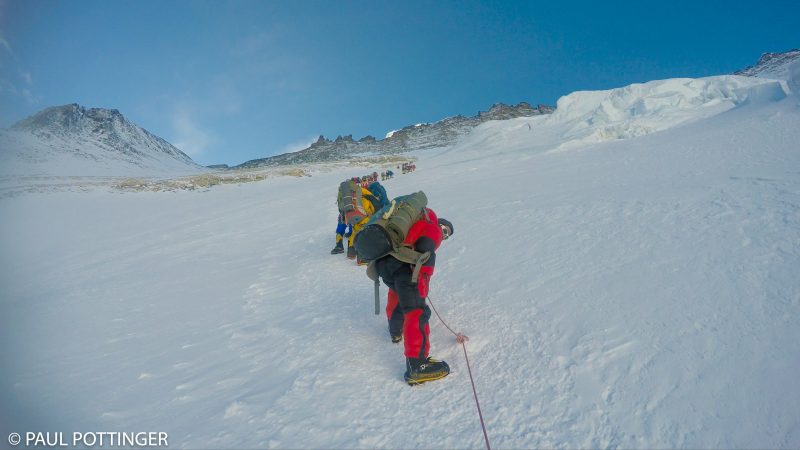
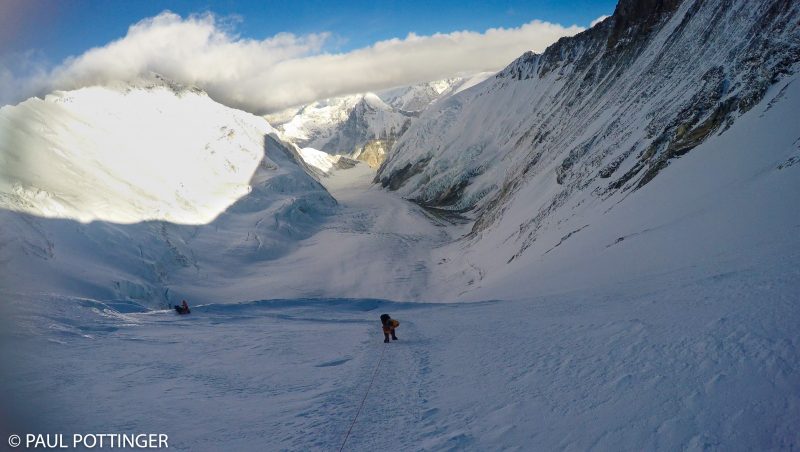
Above that first ice bulge, the route continues straight up the Face, then cuts a climbing traverse to the left, ending in the Yellow Band. The Band is one of Everest’s most celebrated features: A layer of yellow rock that winds its way across the upper mountain. On the South side, the route crosses the Band at approximately 24,700 feet. Its lower edge is a small cliff, about 30 feet high. Above that, it rises obliquely for perhaps a hundred feet until it merges gently with the ice of the Face. It is a fabled obstacle with a reputation for being challenging to overcome, some say even tougher than the Hillary Step. I wanted to be in prime shape for the cliff, and decided to take a sip of water from the CamelBak.
Nothing.
I took a couple breaths, then tried again. Again, it felt like sucking on a stone. Must be a little ice in the line… had I remembered to blow back after that last sip? I could not recall… maybe the chaos of the accident had distracted me. Only a little ice in the tubing that I could see… Should be fine. I blew as hard as I could into the line, blew until my ears popped and air bubbled from the corners of my eyes. But, no good: I could not clear the line. The bite valve itself must be the issue. I chewed on the valve like a gummy bear, breathed on it, spit on it, probed it with my tongue, kept it in my mouth… anything to warm it up. No good. When I massaged it with my gloved fingers, I expressed a thick, rubbery, odd kind of ice from the opening, like nothing I have seen before, but reminiscent of plastic sea ice. The electrolytes had depressed the freezing point, but not low enough.
I fought a sense of panic. You are fine. It will thaw later, when the temperature rises… if we get sunshine. The bladder is still full of liquid water, feel it sloshing against your back under the suit? You can pour it into the 500ml Nalgene at a break. Ang Kami has a whole hot liter for you in his pack. You will be fine. Still, I wondered what else would go wrong that day.
The sun rose above Lhotse and flooded the Face with light, and some warmth too. I had chosen to start out from Camp 3 without wearing eye protection, because the wind was light, and goggles and glacier glasses inevitably fog up when I sweat. The only question is when it will happen, and the longer I can go without wearing them, the longer it will take for them to fog. But, once the sun hits, there is no other option: eyes must be covered, lest corneas become sunburned. That morning, when we sat down to take a short break below the Yellow Band, I reached into my down suit pocket and pulled out the goggles: not only would it be bright, but also the wind was picking up. Might be more than minor katabatics…. I watched spindrift swirl down on us in miniature vortices. Miolangsangma, please stay calm today. Goggles tend to fog up faster than glacier glasses, but they afford much better wind protection. Getting into goggles always feels like I have stepped out of the weather and into a warm house: the comfort is immediate, and my whole face—indeed, my whole body—begins to relax.
High clouds scooted in, filtering the sun, and creating a sundog: a circular rainbow surrounding the sun like a halo. I smiled, cracking the seal on my mask, when I remembered seeing sundogs for the first time with my buddy Dev in Antarctica. He’s Irish, and the concept of a leprechaun chasing itself in circles in search of the pot of gold blew his mind. Vinson seemed like a lifetime ago, even though it had actually been just two and a half years.
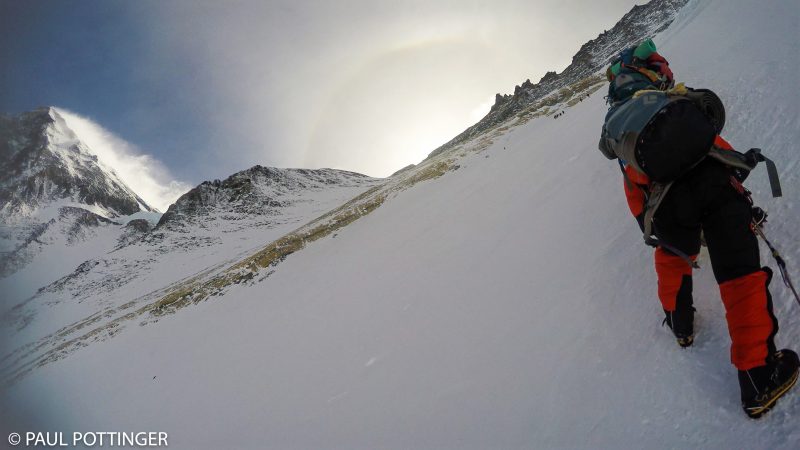
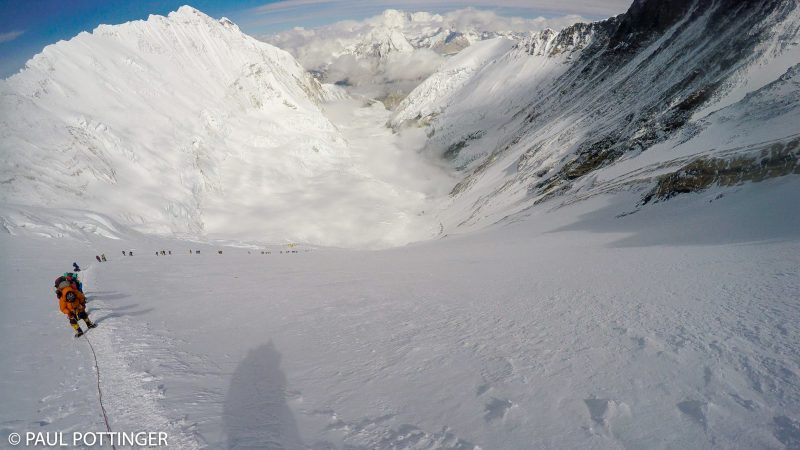
Nima Dorje, Cristiano, and Emily Johnston arrived at the break spot. Cristiano looked remarkably good—indeed undaunted—with his trademark smile. He had injured his hip in the fall, and sustained a swollen lip and left cheek. He denied a headache, but I knew that he had bumped his head, so while he ate an energy bar I lifted his fleece hat: A golfball-sized hematoma sat just above his right eye. “Holy shit Cristiano. Does this hurt?” He had no idea what I was talking about. There was no stepoff or deformity around it… he had not fractured his skull, just suffered a big, big bruise. And I thought, Maybe those helmets were not such a bad idea after all. “You’re looking good, man.”
“Thank you.”
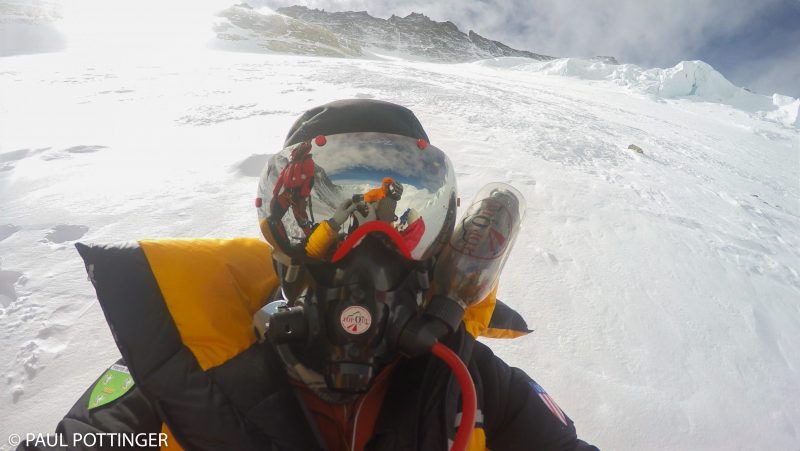
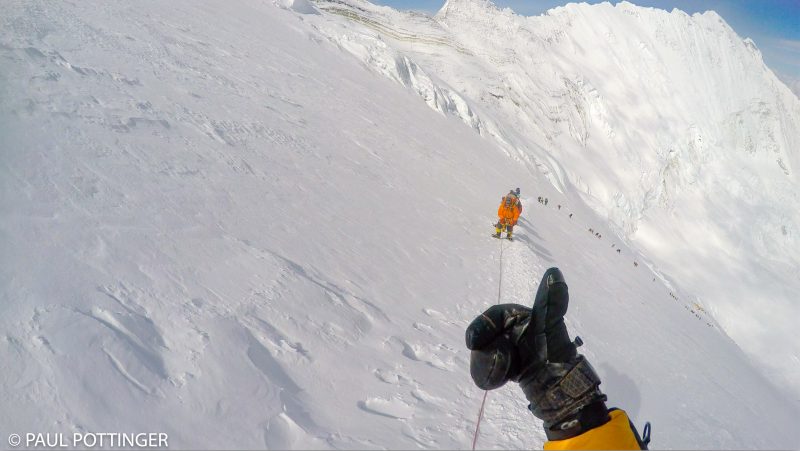
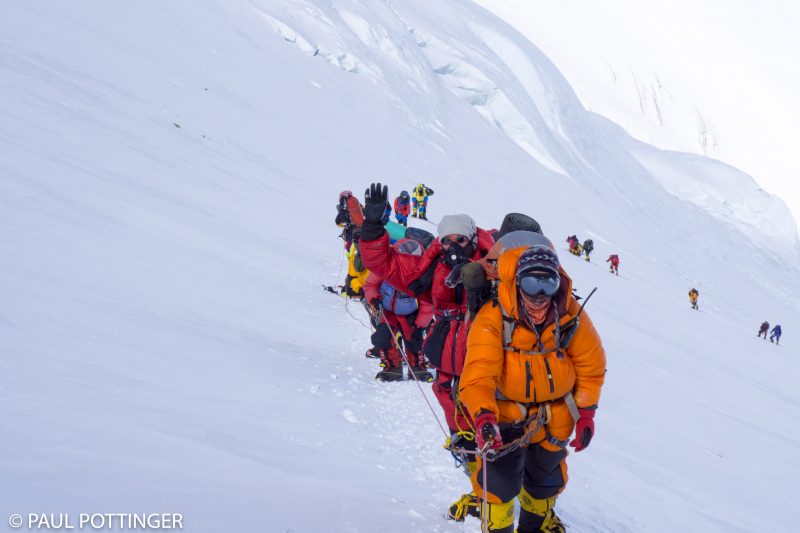
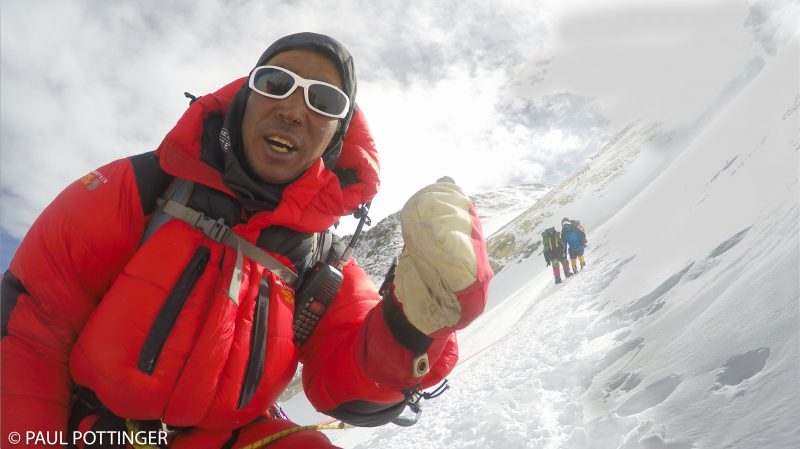
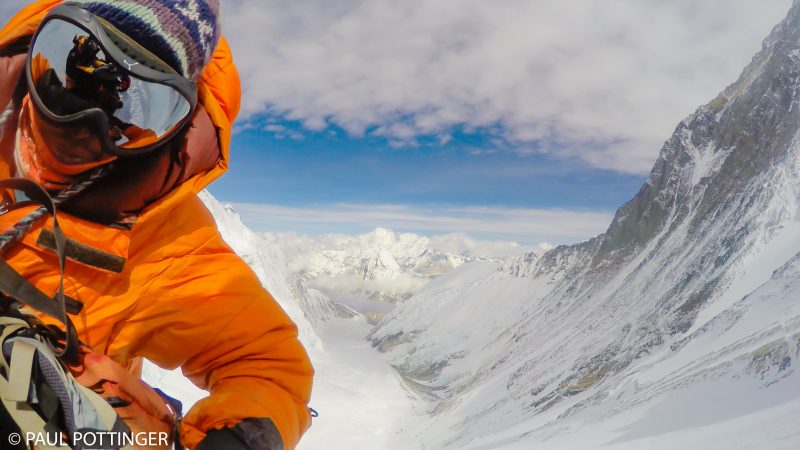
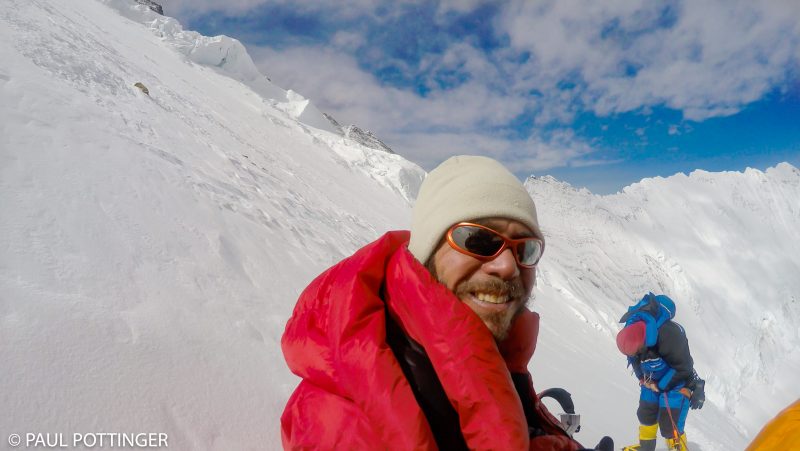
When we packed up to leave the break I dropped a small ziplock bag containing the T-splitter for my oxygen system. It instantly slid down the face, on a slow and majestic trip down the mountain. I did not need it again, because we would breathe our own O’s from here on up… in fact, I should have left it at Camp 3… but, this served as a good reminder to keep my kit together. Leaving rubbish on the mountain is a cardinal sin, at least in my book. That day I shrugged it off because there was simply nothing to be done once it fell beyond my reach.
Moving up the route, I focused squarely on the Yellow Band. Our team’s column packed tightly at the base, in fact remained tight all the way up the cliff. Why are they moving so slowly? Almost as if on queue, Greg called from EBC for a situation report, and Justin replied from the top of the Band in a very chipper manner: “Well, we’re stuck in a traffic jam of our own making!” Greg’s laugh was unmistakable over the radio, and he commented that at least we couldn’t get upset about the traffic if we were the cause. In fact, some climbers from other expeditions had become inserted in our midst, but he was right: most of the Band was being climbed by IMG. A second rope branched off to the right, up a steeper section of the cliff, but this was really for rapping down… there was no choice but to stand in line and wait.
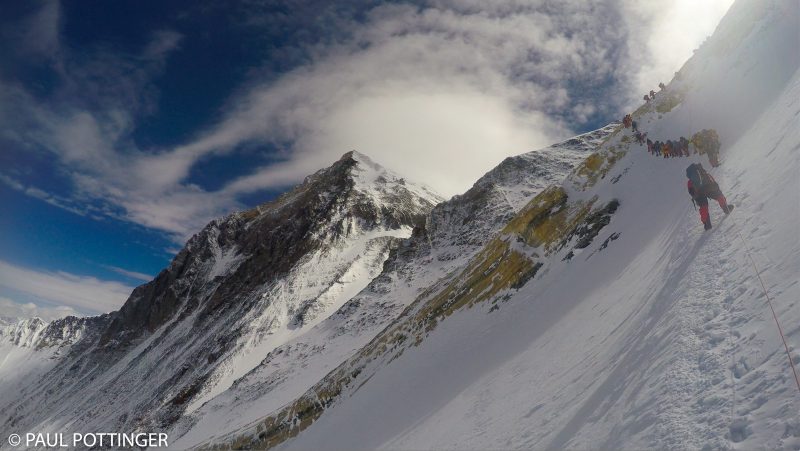

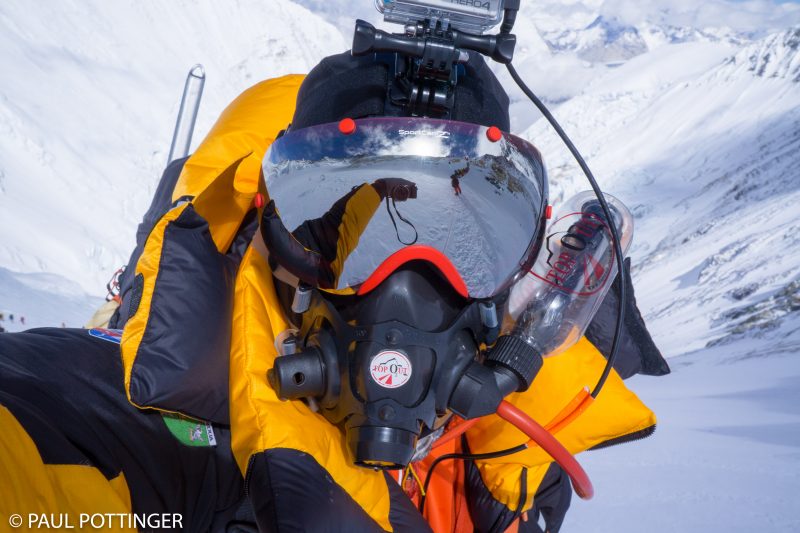
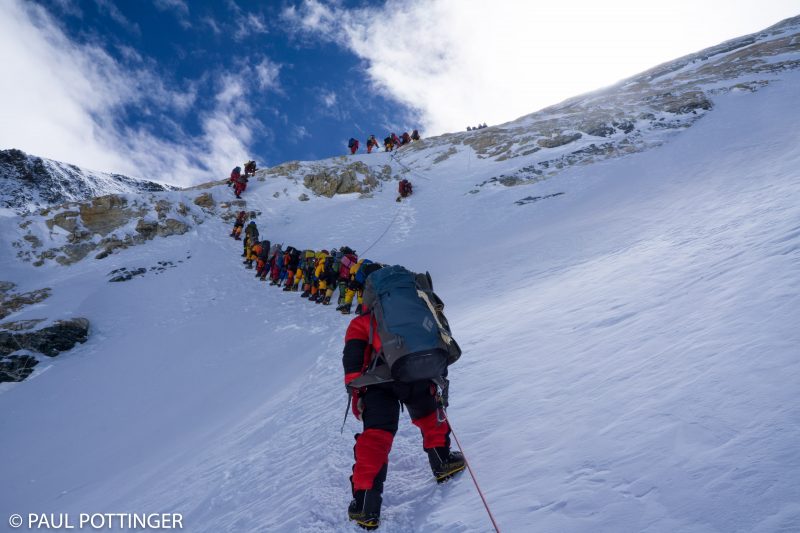
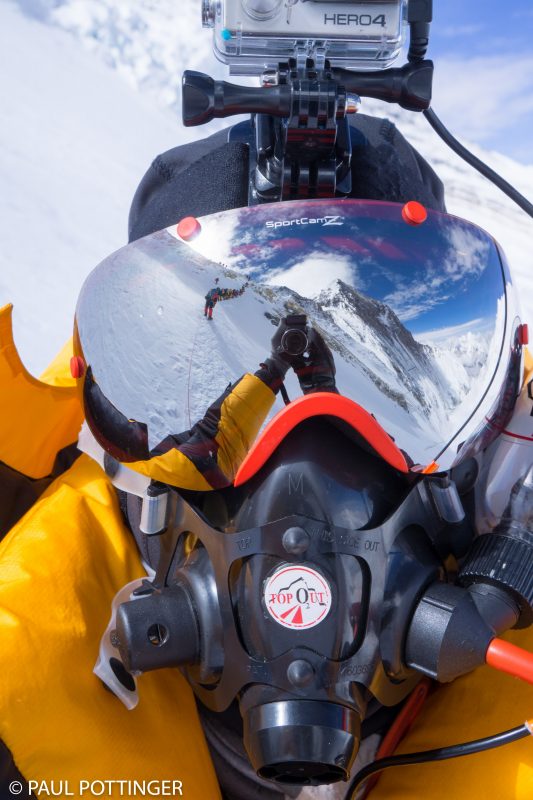
Two climbers descended the rap line, then walked towards us. Because the slope was so steep, we were forced to stay on the same downhill side of the line. Passing was awkward, with a drop of about 3,000 feet below, and steep ice above. The first of these climbers chose to unclip totally from the line once he reached me, because his tether was not long enough to clip past my body. Instinctively, I grabbed his pack to support him until he clipped the line again. Holy cow, I hope we don’t have too many more of those today. I knew that there were more climbers above, eager to descend after summiting yesterday, and I wanted to make the South Col before they all started down.
Gradually, the conga line moved up the Yellow Band cliff, one step at a time. Amazing… the rock really is yellow! A second line was fixed to the face, a yellow twisted static rope that looked to be several seasons old but still perfectly fine as a backup. I positioned myself between it and the main climbing rope. Having two lines was a luxury, and allowed me to ascend with greater confidence and safety. Climbing this section was awkward because of the bulletproof blue ice hiding under a couple centimeters of fluffy powder… because of the mixture of snow, ice, and rock… because it was very steep… because there was so little air to breathe… because climbers traversing above were kicking tennis-ball-sized snow bombs down onto us… and because the folks ahead of us were genuinely slow. At this point, I was breathing 3 liters per minute, and they may have been at a lower flow rate. They were not with our team, so I have no idea. All I knew was that they seemed to be moving in a trance, as if wading through molasses. They huffed and puffed after every step. That must be what I looked like on the last rotation. I could manage this cliff with two or three breaths per step… they seemed to take ten at least. At the top they stopped entirely, and fiddled with gear for what felt like long minutes. I’m perched on my front points here, dudes! Get out of the way! I repositioned into a French herringbone stance and rested my gastrocs that were starting to pump out. One of the climbers handed a metal thermos to the other, and they started moving again, staggering upwards. What the hell.
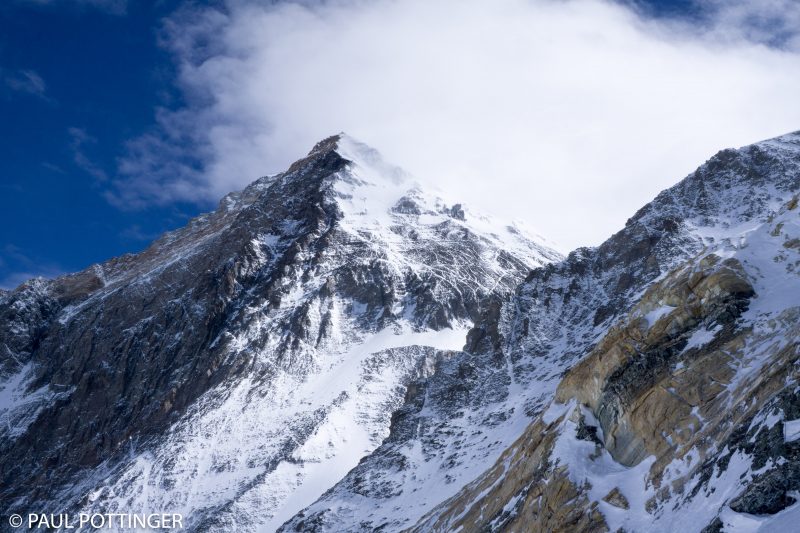
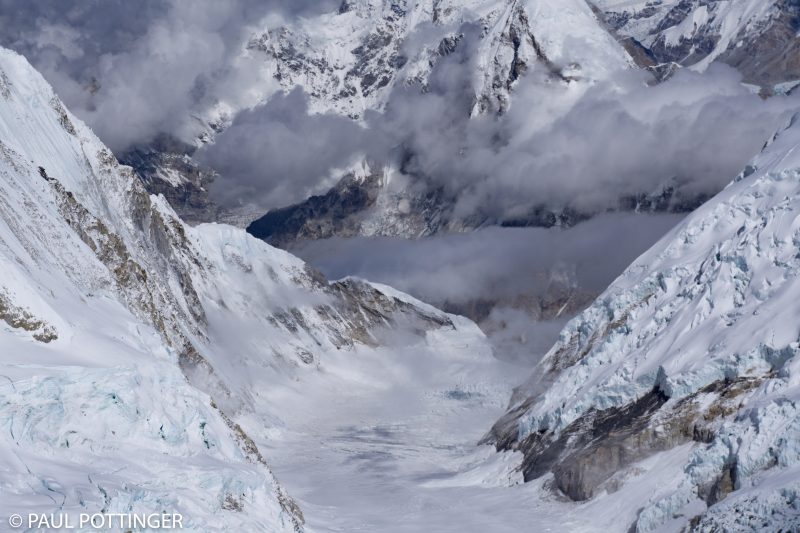
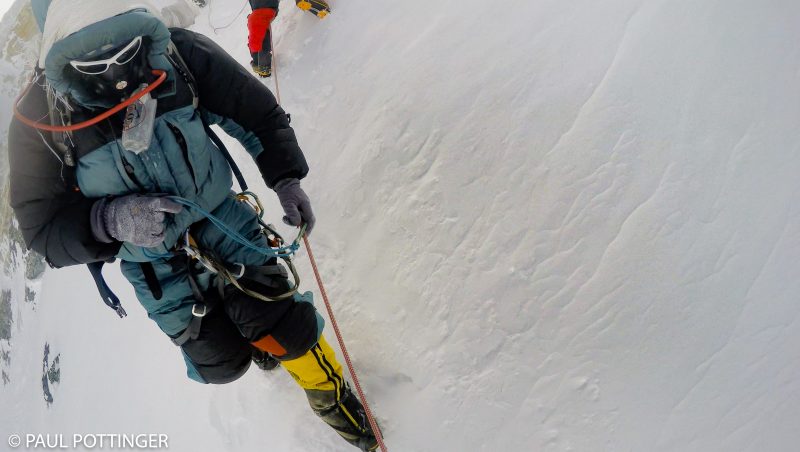
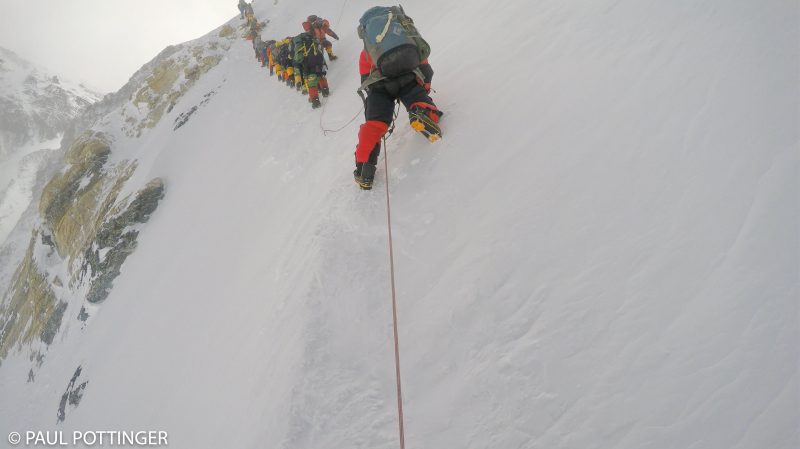
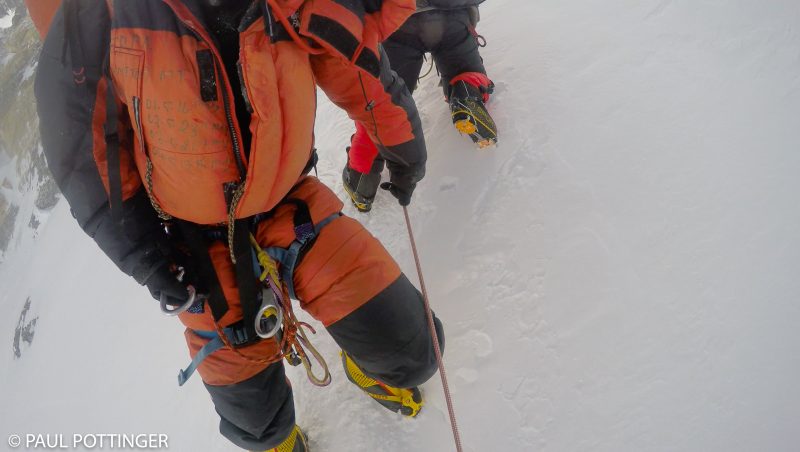
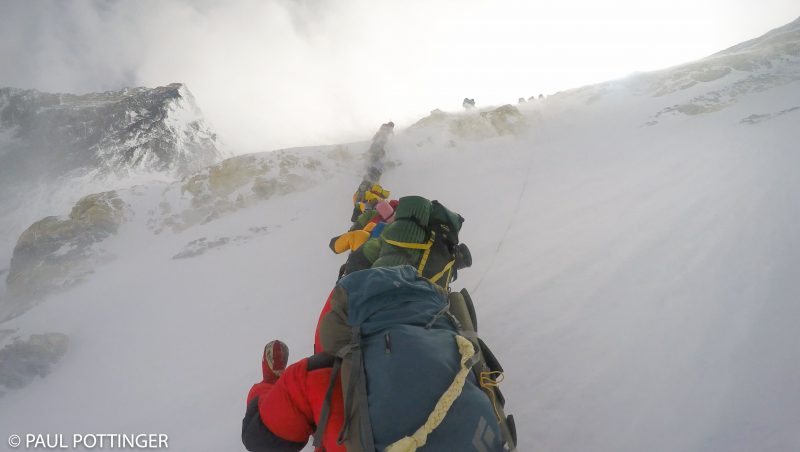
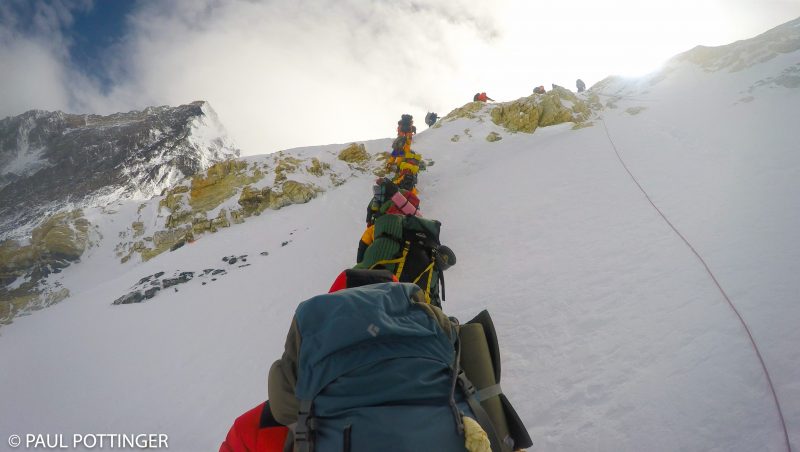
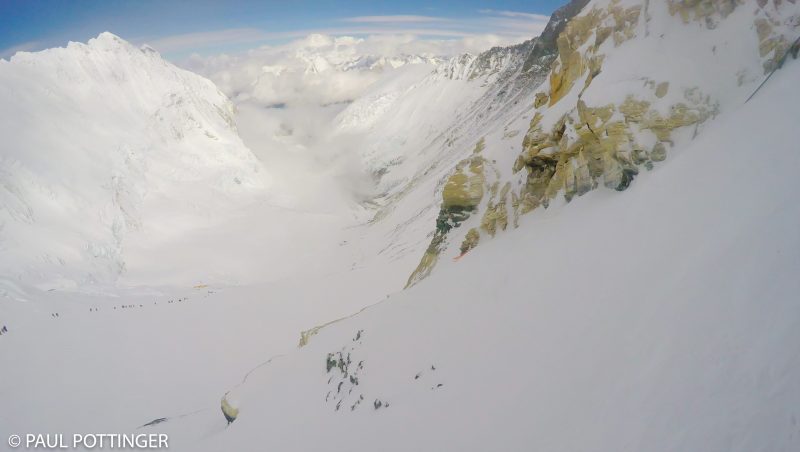
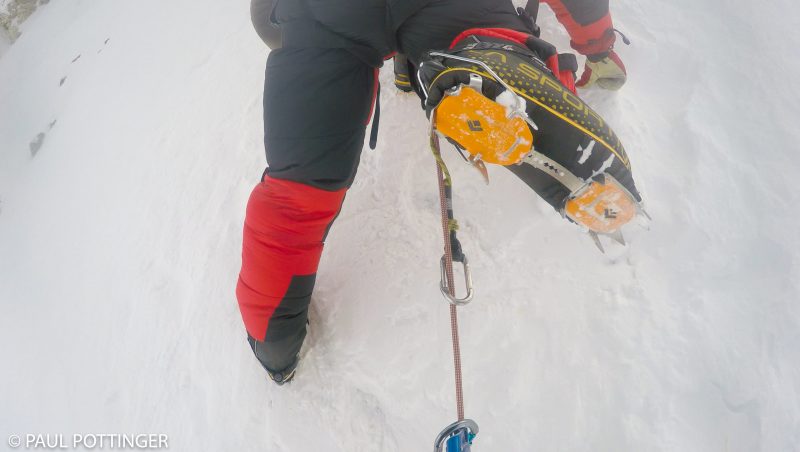
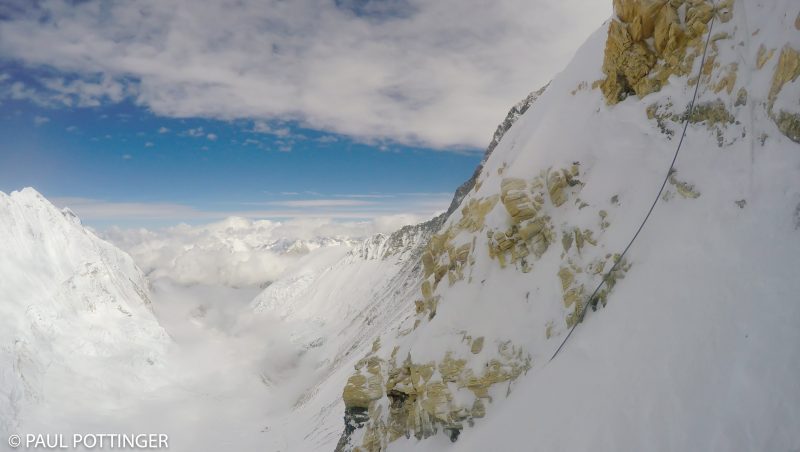
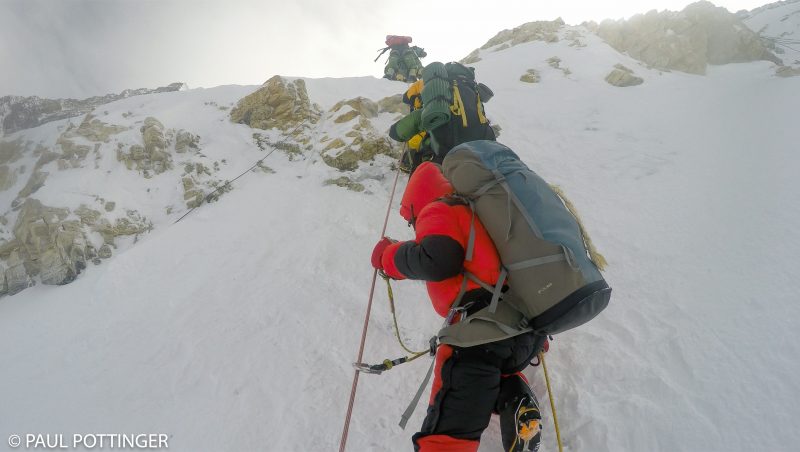
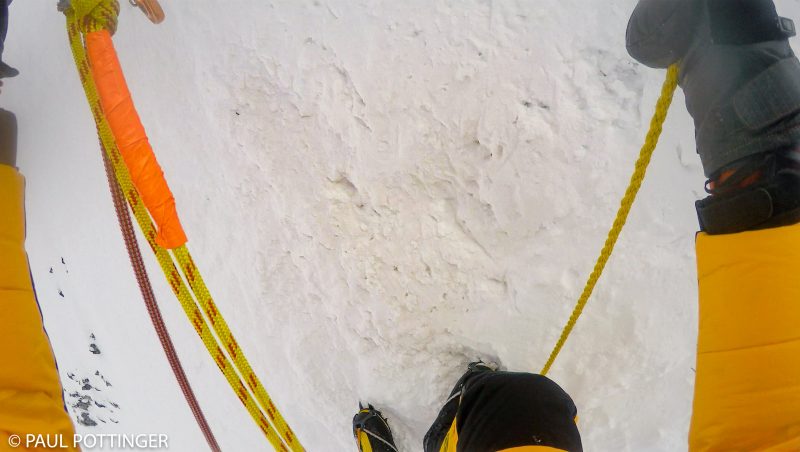
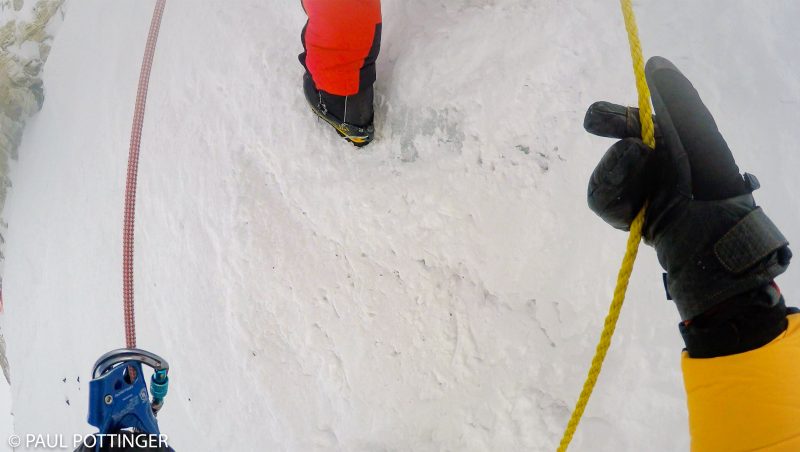
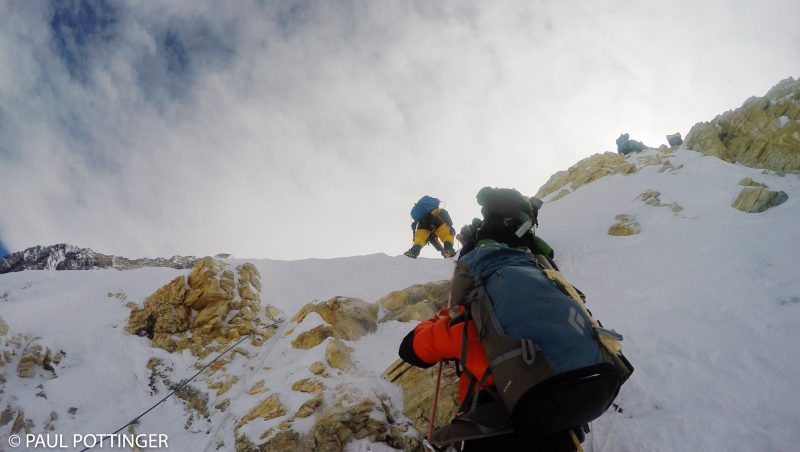
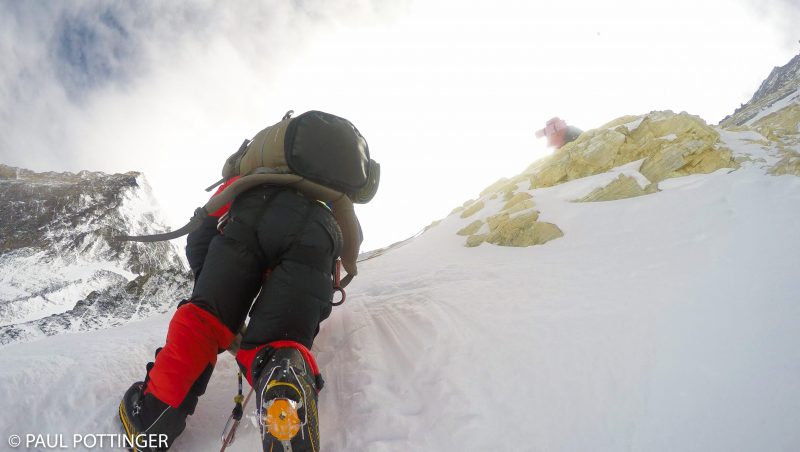
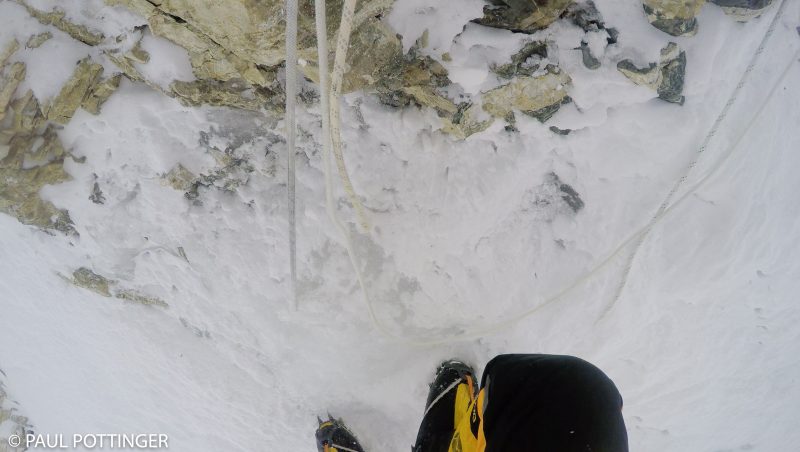
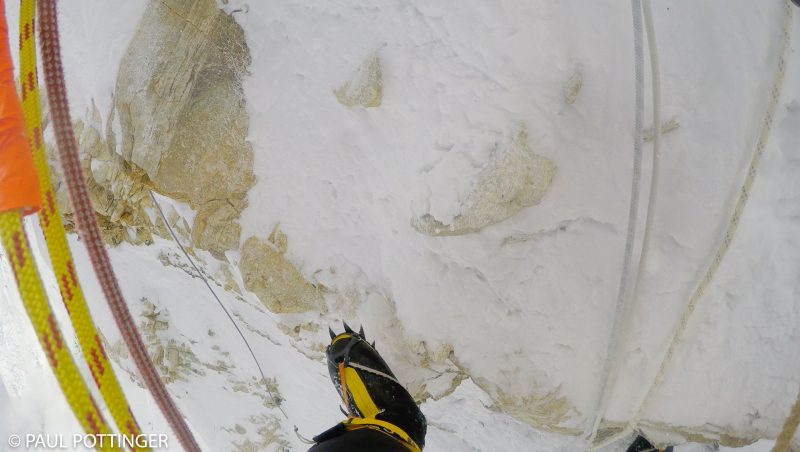
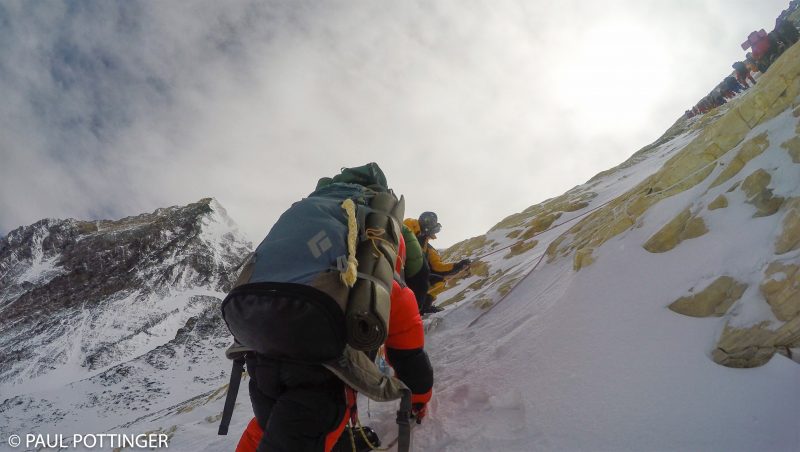
Jugging up the Band, I had a flash of pain in my right side: ribcage pain. This feeling in the right side of my chest had started with the respiratory illness I had acquired earlier in the expedition: Sharp, stabbing, severe, and instantaneously triggered by coughing. But, so long as I did not cough, I had no pain. Back then, it was clear to me that I had strained or perhaps even torn an intercostal muscle… the realization that I had in fact fractured the rib did not strike me until after I was safely home. As a physician, making the diagnosis of a broken rib should have been easy. But I was trying to diagnose myself. I must have subconsciously suppressed this possibility. If not, I would have to admit that I was climbing Everest with a broken rib… and that would be crazy. Besides, so long as I kept my chest and arm at the proper angle, and so long as I did not cough, it really did not hurt.
As Pasang Kami and I topped out on the first cliff, I saw that the column had pulled away from the pair of “slowpokes” in front of us. It would be challenging to catch up now. A few rock bands and mini-cliffs cut across the broad snowfield that banked steeply up towards Lhotse. We climbed on the line anchored to the snow between these rocks. At one particularly steep point there were again two ropes in parallel, intended to reduce traffic by providing an up and down route. Great idea! Too bad some descending climbers chose to clip into the line we were already ascending. Again… what the hell. I watched Nima Dorje and Cristiano negotiate this tiny traffic jam, gave them a thumbs up, then turned my attention to the route above.
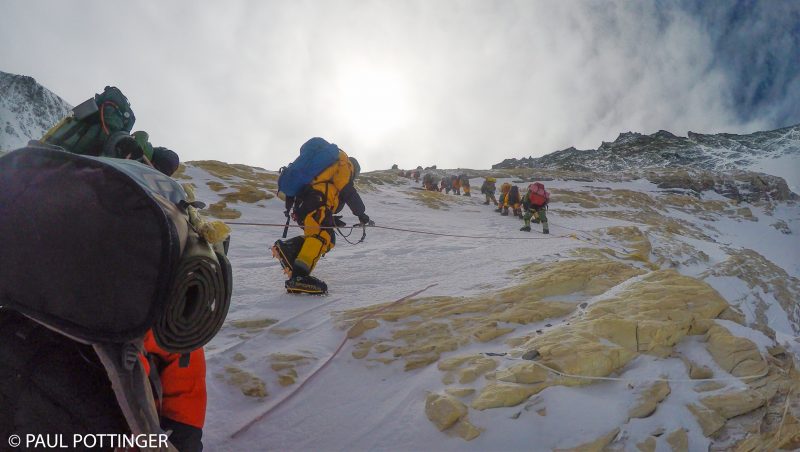
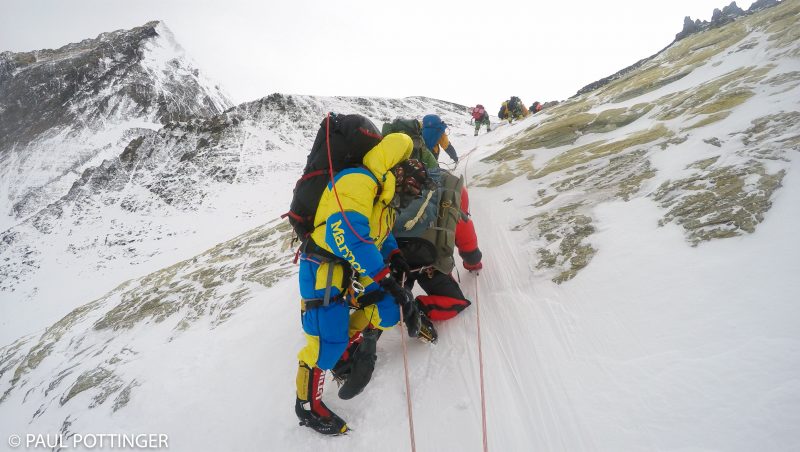
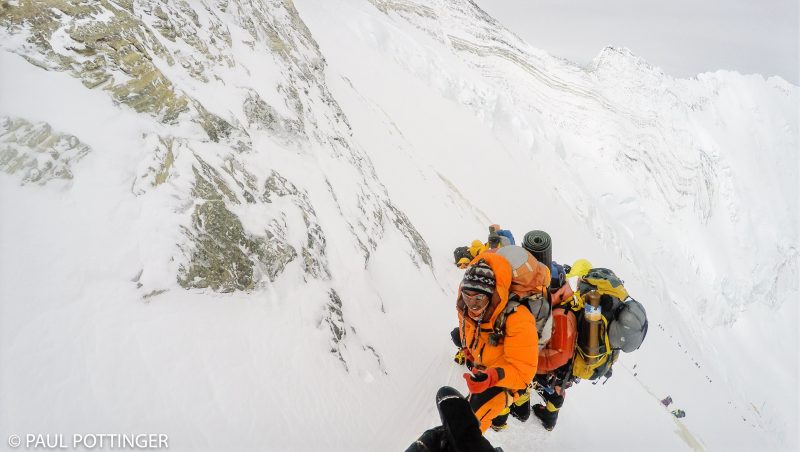
The Lhotse Face moderates a bit above the Yellow Band, where the mountain resembles a vast snowy bowl. At the far end of the bowl, on climber’s left, is a dark stone cleaver, a small peak that stands up like a whale fin against the sky: The Geneva Spur. In my imagination before the expedition, it was not much of an obstacle at all, a simple choss pile to be hiked across, like being on Kilimanjaro again. And, from here at the top of the Yellow Band, the Spur did look quite benign. There was a solid line of climbers coming down its face, descending obliquely to the bowl… and another knot of climbers heading up, right at them. I watched this for a moment. And my heart sank. Yesterday’s summiteers. Here they come.
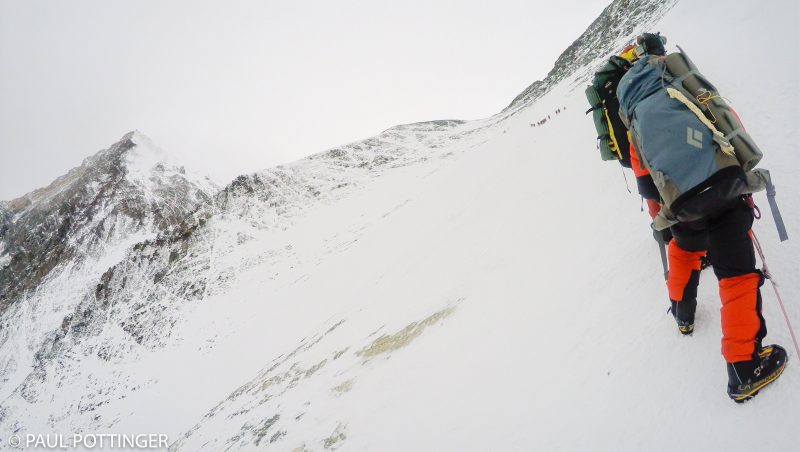
As we trudged upwards, towards the descending climbers, I saw a rope split off to the right. That’s the rope to Lhotse high camp. Sure enough, a tight cluster of four tents sat at the top of the line. Above that, a thin, long, stunningly straight snow-filled couloir shot up to the black summit block of Lhotse. Our plan had been to climb this mountain after Everest, to tag two of the 8000ers in one expedition. It was Kim’s suggestion originally: like her, this plan was bold, audacious, and slightly mad. Wonderfully, refreshingly, undeniably mad. Everest would be the biggest climb of our lives, and to head up above 8,000 meters again the day after summiting Planet Earth was a very tall order. Come to think of it, Kim may have suggested the idea casually, on a lark. Regardless, although it may have been her plan, the idea had rooted deeply in my brain, where it flourished. For months Lhotse had fed my dreams, inspired my workouts, and tantalized my imagination in every sense. The expedition would be even more remarkable for this “twofer” accomplishment. In the end, it did not pan out: the extra expense was just too much for us to secure early enough in the planning process. When our deadline passed, and I realized that Lhotse would not be in the cards, part of me suffered and died. I mourned the loss of this summit, grieved over it, replayed the climb in my imagination as though I were failing to resuscitate a dying patient.
Now, all these months later, here it was: the line was right there, tied into our rope, heading up the austere couloir to one of the world’s great summits. And I didn’t give a damn. Not one tiny, little, iota of a damn. I’m climbing Everest. Fuck Lhotse.
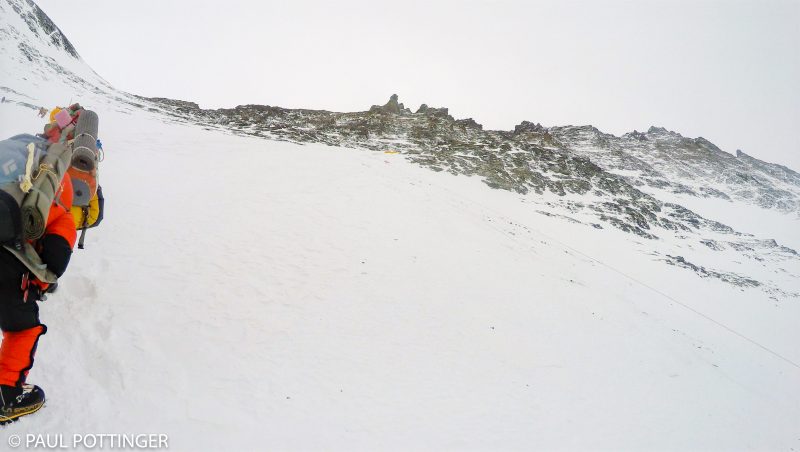
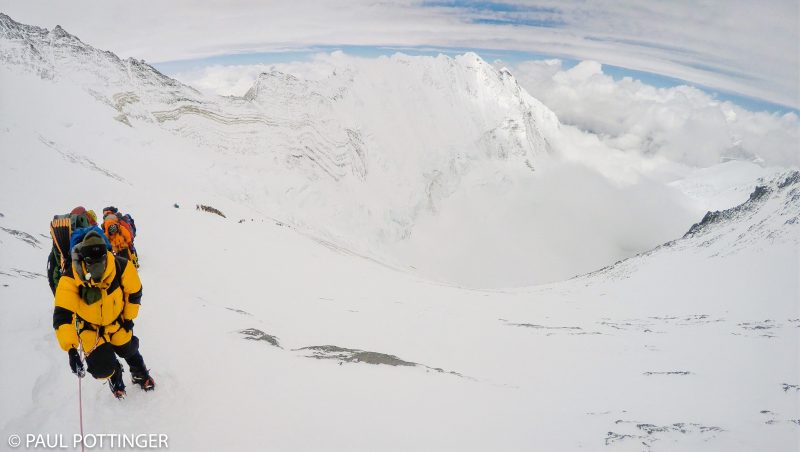
Near the Lhotse line, we stopped to take a short break. Radio chatter picked up, and through my windstopper fleece balaclava I heard Greg thanking and encouraging my teammates above to help care for a fallen climber ahead on the route. I could not make out the details, but it sounded like he knew this particular climber who happened to be with a different expedition and was suffering from some form of altitude-related illness. My buddies had stopped to assist him… he was down, not able to stand or walk, and it occurred to me that this was really bad news above 25,000 feet. I could see them about 200 meters ahead, stopped on what looked like a very gentle, expansive spot on the route, just below the steeper portion of the Spur. They were clustered around the fallen climber on the line, right at the moment when about 50 climbers were descending through that spot. It looked like they could just unclip and lie down in the snow above the trail. Why don’t they just unclip and let the other climbers pass more quickly?
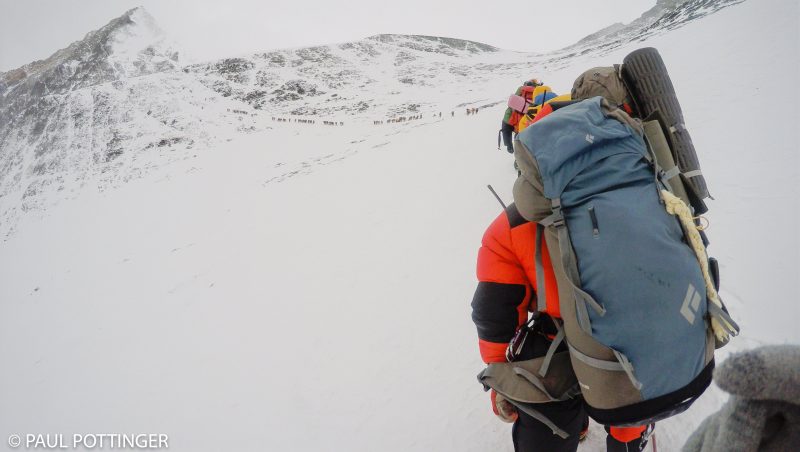
I checked my watch: Jeezischrist it’s 10:30 in the morning! I had planned to make Camp 4 by 11:00. That way, I knew beyond the shadow of a doubt that I could breathe 3 LPM the whole way up. Now, with the accident and with all this traffic, I still had to make the upper traverse, climb the Spur, and haul ass to the South Col. It sure as hell won’t be a five-hour day. Perhaps noon….? Dammit. I knew what this meant. I was still wearing my pack (taking it off was always a slow experience), so I asked Pasang Kami to turn my flow rate down to 2.5 LPM. I heard the hissing gas become slightly quieter, and it filled the reservoir a bit more slowly, not what I wanted on my way up Everest. I did not know how many PSI were left in the bottle, but it did not matter. Converting PSI to LPM and estimating climbing time left was beyond me at this point. Barring a catastrophe, I knew that I could make it on this lower rate for a couple more hours, probably longer. It’s OK… 2.5 is still plenty. You’ve got this.
Moving again, the column of descenders came closer and closer… and suddenly we were jammed together on the line at a virtual standstill. One rope, two directions of traffic, and no margin for error. Fortunately the incline on this portion of the traverse was relatively gentle, so everyone had a good stance during the passage. No talking was necessary: those of us going up had the right of way, and those descending needed to move their safety carabiners past us, one at a time. When a down-climber clipped past me I would advance my ascender a few inches until it reached the next climber’s gear, then take a step and wait for that climber to clip past. Everyone was courteous and efficient, at least as efficient as this process could possibly be.
As we made this slow, inelegant dance on the line, I fought a sense of urgency. My cylinder was getting lighter by the minute… 3.2 grams lighter per minute, to be exact. The idea of running out of gas before the South Col was terrifying, even though I knew this would not happen now that I was down to 2.5 liters per minute of flow. That Geneva Spur was looking steeper and steeper as we got closer… would 2.5 LPM be enough? Would this crazy traffic jam cost me my dream?
As always, the Sherpa climbers displayed stunning strength at altitude. One who passed me had a full pack, so full that his extra gloves were strapped to the lid… and he had empty Poisk cylinders strapped to his pack. That guy has three cylinders—no, four! Wait… five… six… SEVEN cylinders on his pack! SEVEN CYLINDERS! Even in my altered state of mind, I thought: How much is that guy earning up here? That does not look safe to me.
A lighter moment during the passage: A climber saw the US flag on my sleeve and became overjoyed. “An American! Alright! Awesome, dude!” We pounded gloved fists. “You got this, man.” I really wanted to be in his position, descending to Camp 2 in triumph. That will be you tomorrow.
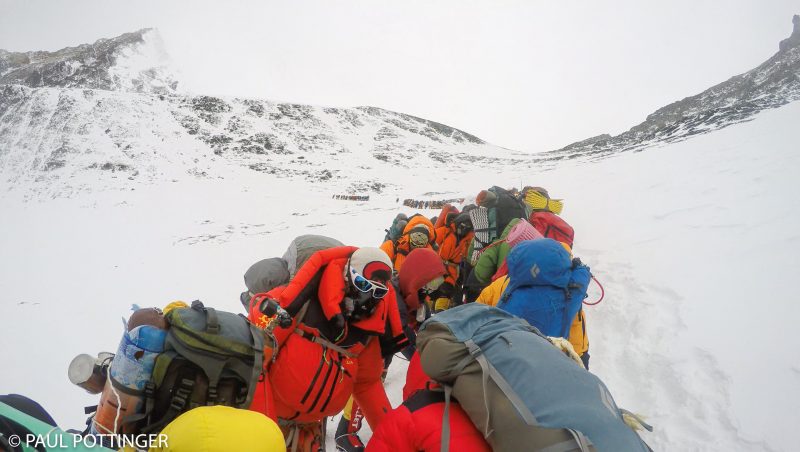
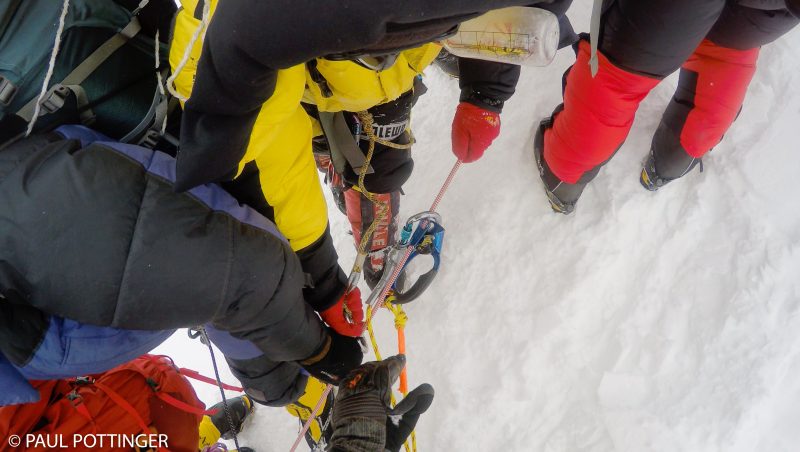
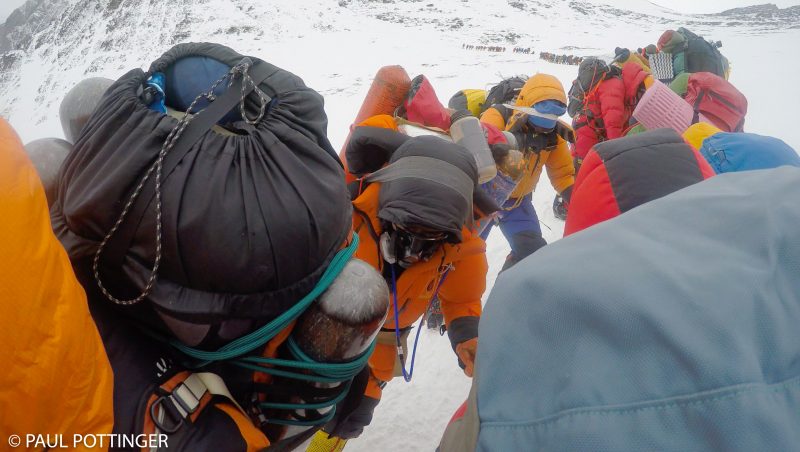
Past the main knot of down-climbers, the route opened up and I thought I might be able to catch up with my friends in the lead… but it was not meant to be. I felt perfectly fine, but not fine enough to unclip and pass those ahead of me. No way. This was a conga line, and I would force my rage into a bitter little ball and swallow it. I focused in an irrational way on the technique of the strangers around me: Why don’t these guys use the rest step? Instead of standing still and then sprinting for five steps and then stopping again, all they needed to do was pick a steady pace and stick with it. Lock the lower leg, bone on bone, for just a moment with each step and you ultimately go so much farther. Mountaineering 101. But no. Also not in mountaineering 101: Smoking a cigarette at 25,400 feet. But, that’s what the guys ahead of me decided to do. Fortunately, lighting up took a bit of effort in the wind, allowing me to pass and charge ahead.
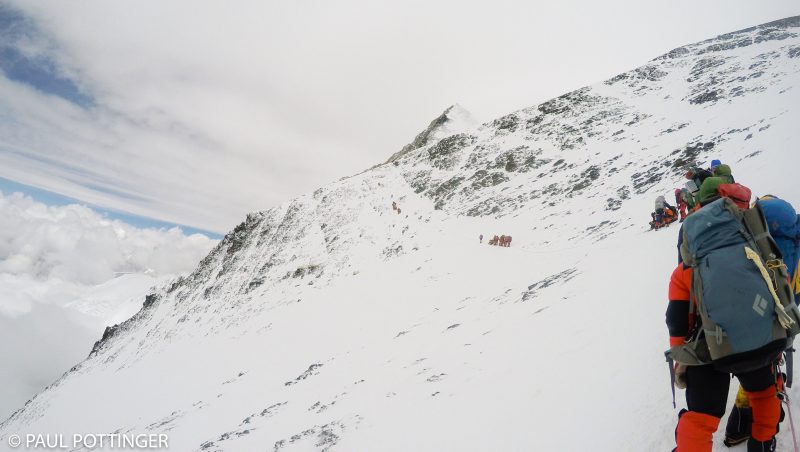
I reached two of our teammates, Nicky and Bob, resting with their Sherpa guides at the exact same spot where the ill climber had been. In fact, I expected to see him lying there… but he was gone. I realized that he must have been revived enough to walk down with assistance… I had passed him in the knot a few minutes earlier without realizing it. Awesome!
Nicky saw me approach and raised her hand, waving in a friendly way. She sounded hale and strong, as always. “How ya doin’ Doc?”
“OK.” I took a few breaths. “What flow rate are you at?”
“Two and a half.”
“Me too.” This was good to hear.
Bob had just coughed up some snot and was getting back into his mask. “It’s good to see you.” He sounded tired but optimistic.
“You too,” I replied. And it was. After dealing with so many strangers I enjoyed being with my people again.
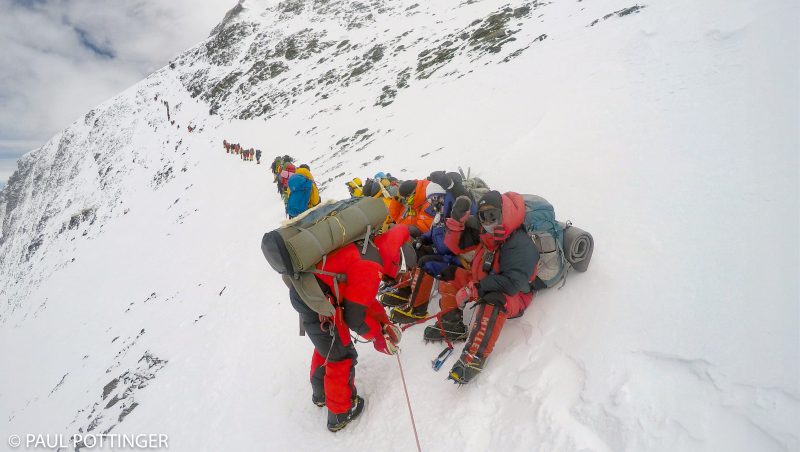
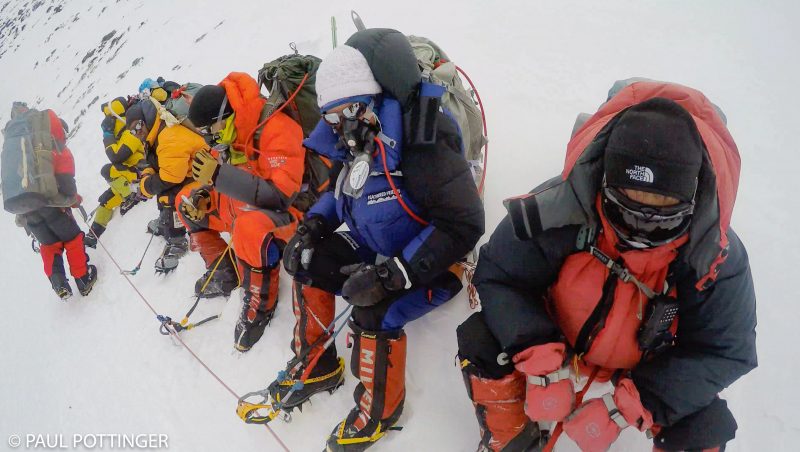
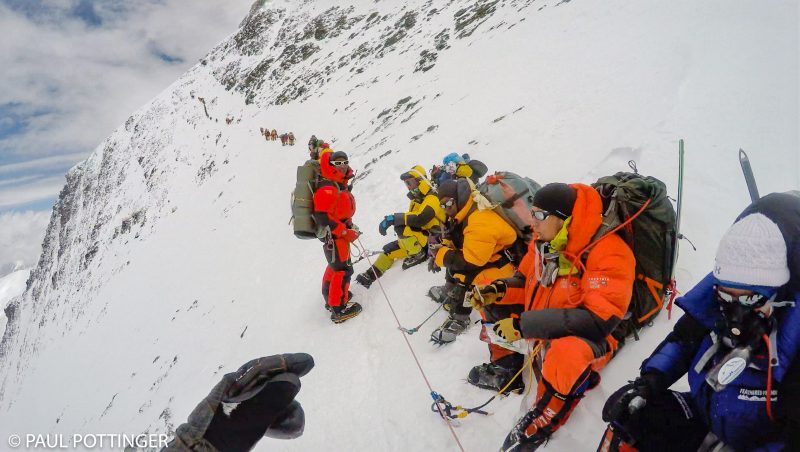
My teammates sat above the line, each tethered to it in an orderly fashion. Pasang Kami and I decided to sit just past them, and thus clipped by each tether carefully. “Don’t mix up ascenders,” said Bob in a dry joke as he watched me work. At that time I was so beat tired that I was not even sure who was talking to me. It was slightly laborious work, and it required all my focus.
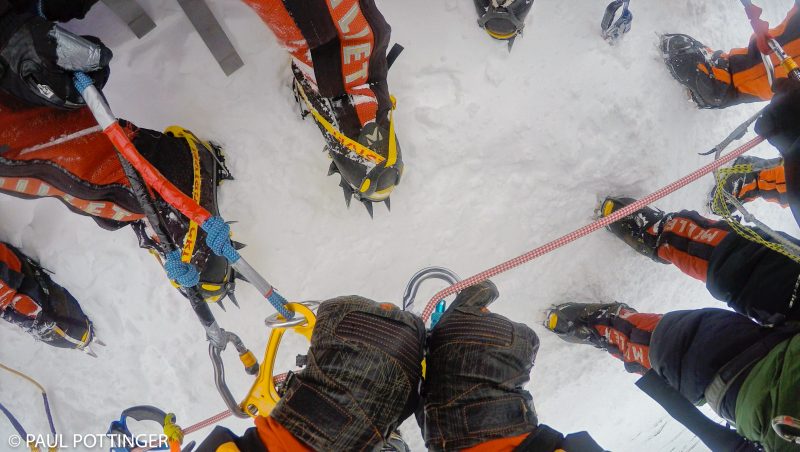
As we neared the end of the climbers on break, Pasang Kami became a bit impatient and helped me make the last two clips… but he moved my safety while I was still transferring my ascender. “Now I’m not clipped into anything. That’s no good.” Pasang Kami has climbed Everest multiple times, and he knows his stuff. For him, speed provided its own safety benefits. He was not wrong… in the Icefall, for instance, we routinely unclip to keep the momentum going. Up here, on a steep face with 3,500 feet of exposure, precision and care seemed worth the extra seconds to me. Especially after the day’s prior events.
Up close, now that I was there in person, it became clear that the “gentle snow field” I had seen from below was anything but gentle. This was a ferociously steep traverse! In the flat light under cloud cover, it had looked deceptively moderate. Regardless of how things may have looked from below, there was no way in hell that anyone in their right mind would unclip from the line here and “lie down in the snow.” I marveled at how illusory my perspective on this place had been just half an hour earlier. In fact, it was just when I was thinking about this that two Sherpa climbers from another expedition unclipped and walked right in front of me. Their steps were confident, steady… and totally unprotected. Can everyone please get up this mountain alive today? I asked myself.
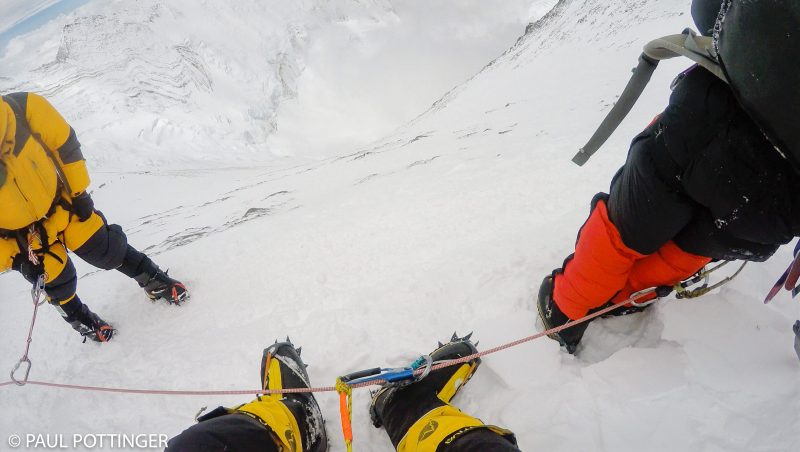
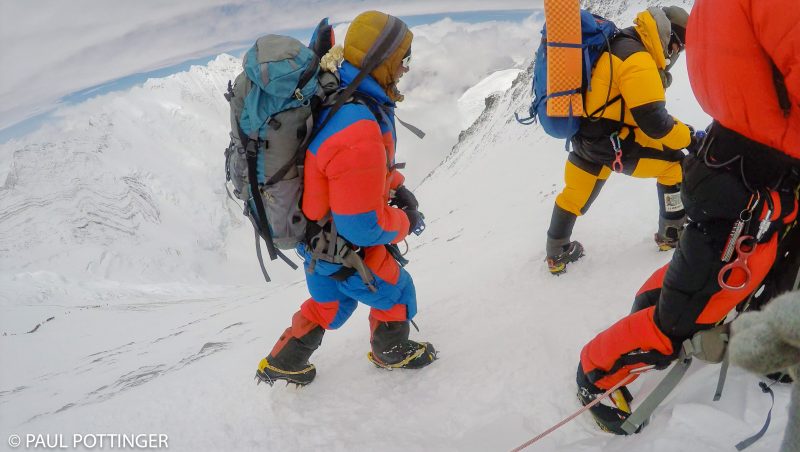
I looked back at our progress so far: Camp 3 was a cluster of tiny tents in the distance. The line of climbers descending was now dropping over the Yellow Band. The weather was holding: winds were picking up a bit, but the sky was breaking into broad bands of blue, so the sun did not cook us alive. Only this last section, the Geneva Spur, separated us from the South Col. We were getting close.
From this final break spot, the route pitched steeply up the Spur. A knot of climbers was climbing it slowly, achingly slowly. Let’s get ‘er done.
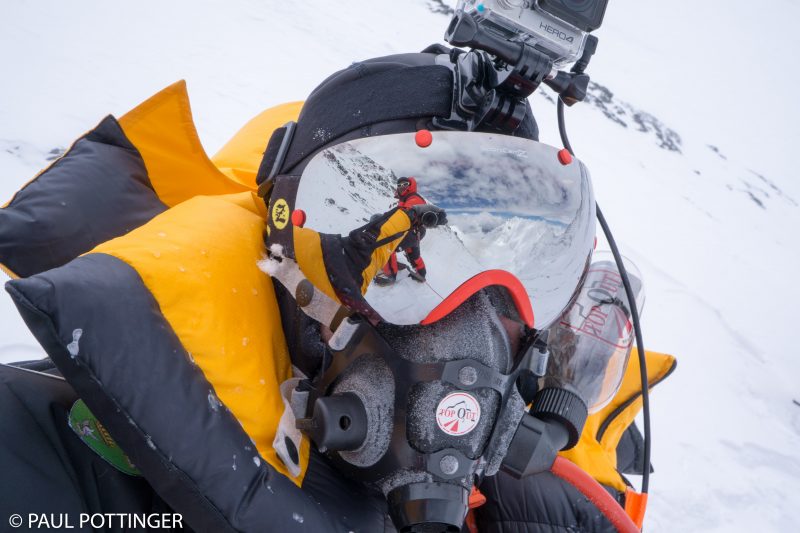
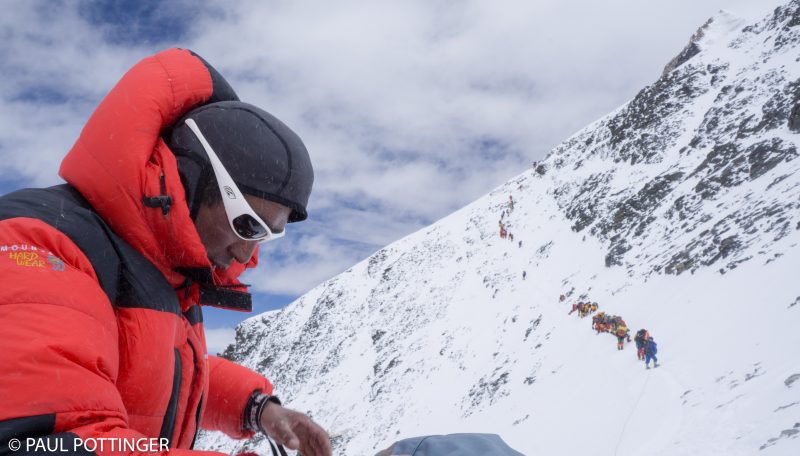
The route crossed steeper and steeper terrain. Eventually, the face was so steep that the trail was scarcely wider than my boot. To the left, the mountain fell away all the way down to the bottom of the funnel below the traverse, then to the Lhotse Face itself below that, and ultimately to the bergschrund, about 3,500 feet below. As we approached the steepest section of the Spur, I saw two Sherpa climbers begin to descend from the crest. Holy cow, not now. This would cause yet another traffic jam. I looked at my watch: Already 11:20 AM. Dammit. Glad I had turned the O’s down, but we were probably still an hour from the South Col, maybe more with all this traffic, and I thought I needed to rely on this bottle through the night. The first climber descended smoothly and steadily, but his partner seemed overwhelmed and exhausted… and was carrying a truly huge load. Come on man, get your shit together.
Just as I thought this, he slipped onto his keyster and started sliding down the face in a sitting position. After a couple meters he jolted to a stop, amidst a cloud of snowdrift…. Wait, that’s not snow… It’s down from his suit! The poor guy had ripped himself a new one, so to speak, and a plume of his suit’s lining was blowing along the winds of Everest, gone forever. Clearly, he would be OK, and I started to relax. Until I saw the oxygen cylinder launch from his kit and begin to tumble down the mountain. It hit a rock band and launched horizontally into the air, not tumbling or spinning, just floating there in an upright position, then landed in a huge plume of powder and began to tumble over and over until it hit another patch of snow. It slid and slid, slowly, so achingly slowly, towards a cliff. I thought of our teammate whose foot was injured the prior day by an errant bottle slamming into him from the upper mountain. “Stop, stop, stop….” But, gravity never sleeps, and over the cliff it went. “Ah! Stupid!” I waved my hand in disgust, and continued up the trail. We were well to Lhotse Face climber’s left, so the bottle would probably slide harmlessly to the Cwm and never be seen again. But this was another sloppy moment on a sloppy day, and I thought, This is no choss pile.
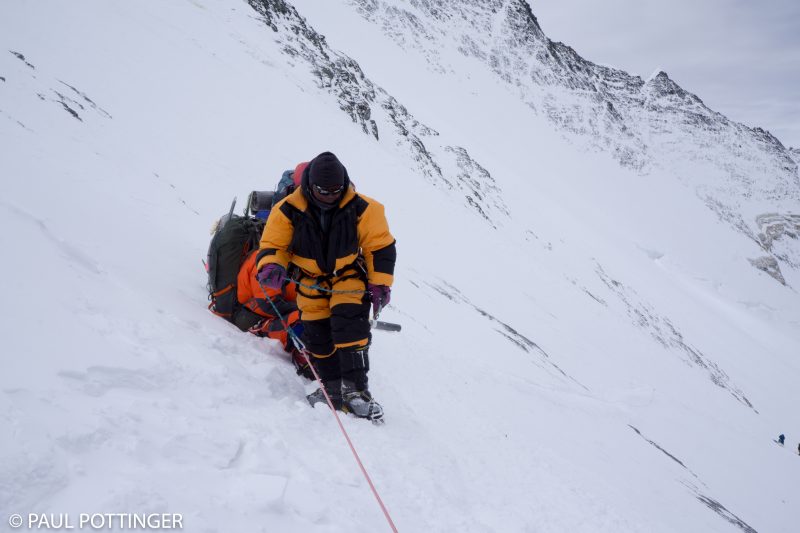
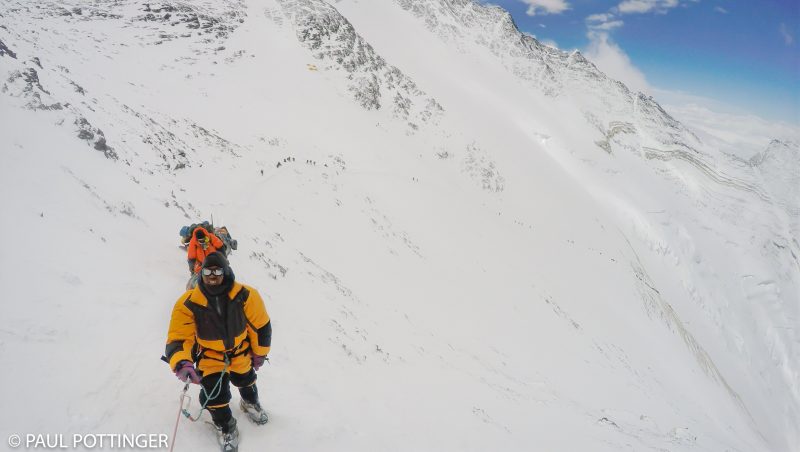
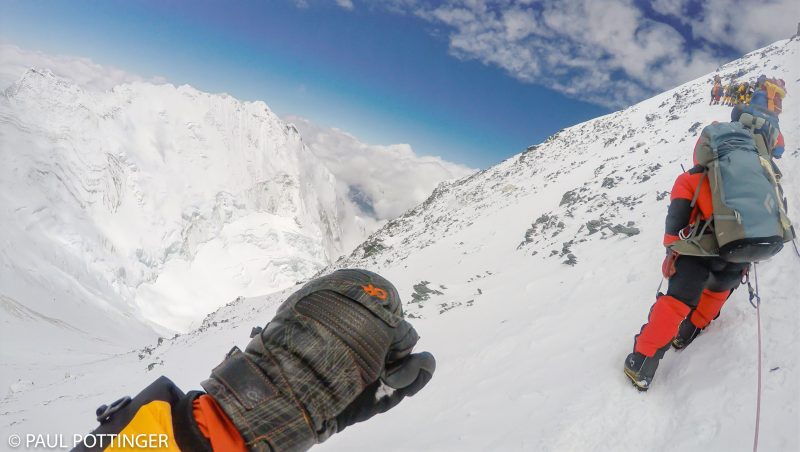
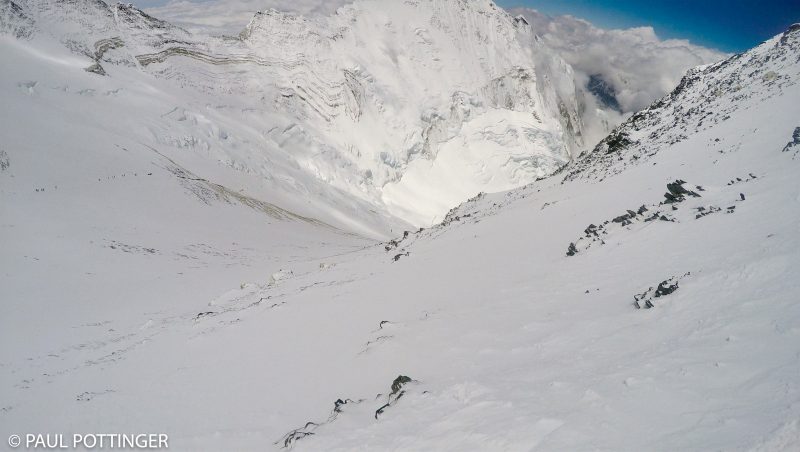
Minutes ticked by while the climbers ahead of us proceeded very slowly. Part of this was caused by the need for everyone to clip past the fallen climber, whose confidence was shaken but who was clearly perfectly fine, except perhaps for a sore tailbone and wounded pride. As I got closer to him I saw that he had been truly overloaded, and I sensed somehow that this was his first rodeo. He did not want to make eye contact with us as we huffed and puffed past. Pasang Kami offered some kind of encouragement in the Sherpa language, but it did not seem to have the desired effect.
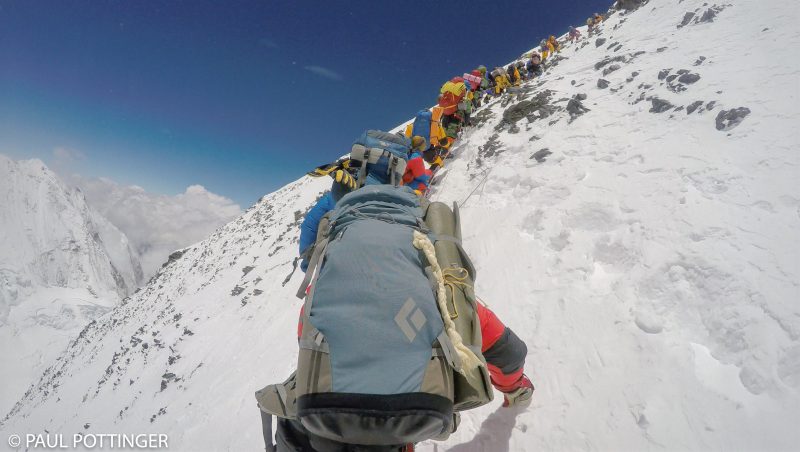
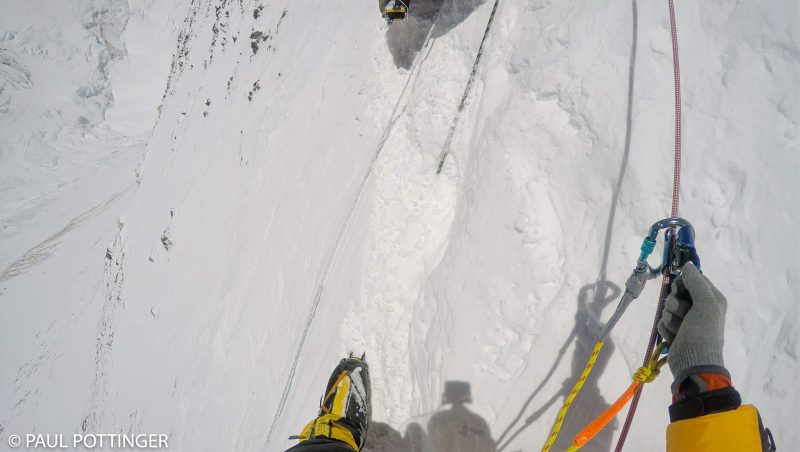
Finally, we reached the top of the steep section. Perhaps a dozen more climbers sat there, waiting for us to clear the line so they could descend. Behind them lay the great expanse of Everest’s summit block, the Triangular Face, slashed with vertical snow-filled couloirs and horizontal dark rock bands. A huge white plume blew away from its right side, soaring over Tibet. The trail flattened out and curved around the crest of the Spur in a long, gentle arc. We made it. I was desperate for a break, but knew it was best to keep walking. “Pasang Kami, how much farther?”
“20 minutes,” he said, clipping past an anchor fixed to the dark black rock of the Spur. 20 minutes. You can do this.
Looking back I saw Ang Pemba and Bob approaching, and waved to them.
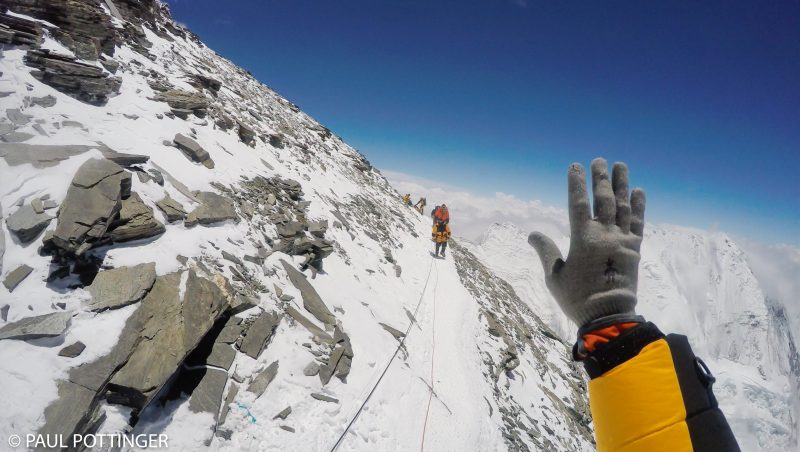
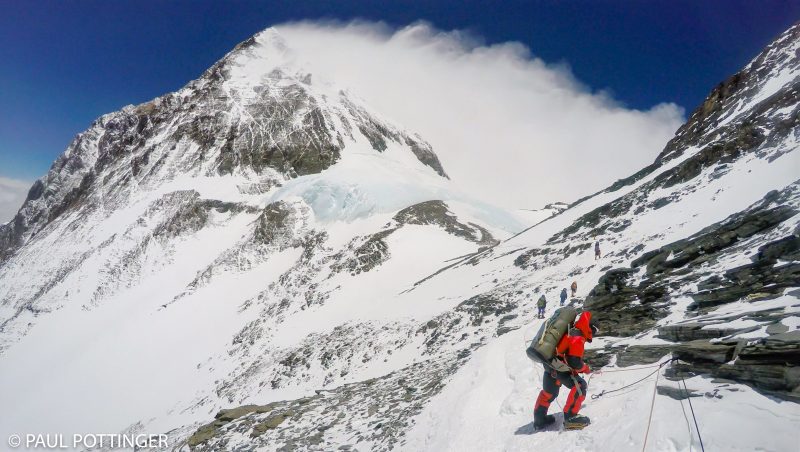
As we got closer to the South Col, one final team approached, a group of ten climbers in red suits. At this point it was 12:45 PM, and I wondered what might have led them to descend so late in the day. If they had been Sherpa climbers, I would have suspected that they had supplied their camp at the South Col earlier that day, but they did not look like Sherpa to me. Rather, they were probably climbers coming down after summiting that same morning.
After this last group of descending climbers, there was nothing between us except a few more steps up a very gentle slope. To our left, the whole Cwm opened up thousands of feet below. Ahead, the last 3,000 feet of Everest itself. Just above Camp 4, below the Triangular Face, lay a burly hill of blue ice cracked with crevasses that were themselves packed with pure white snow. I wanted to soak in the beauty of the place, but I was knackered coming into the South Col, and needed to collapse into my tent and rest. Almost there….
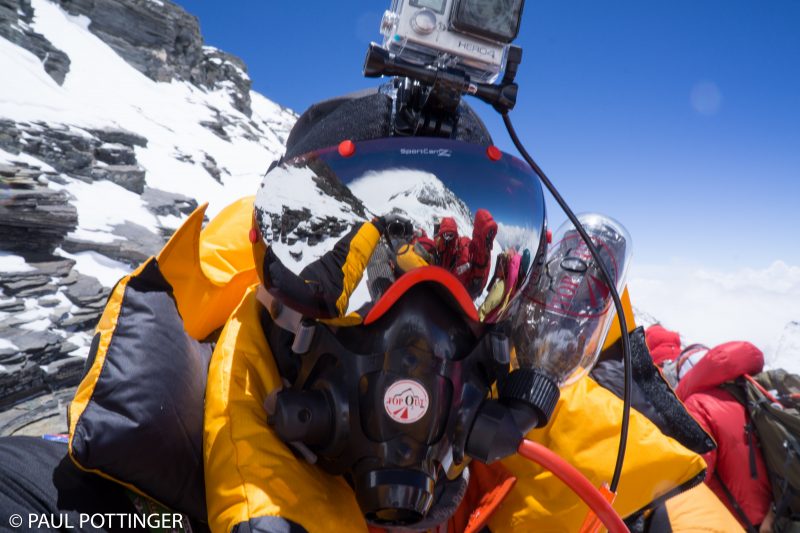
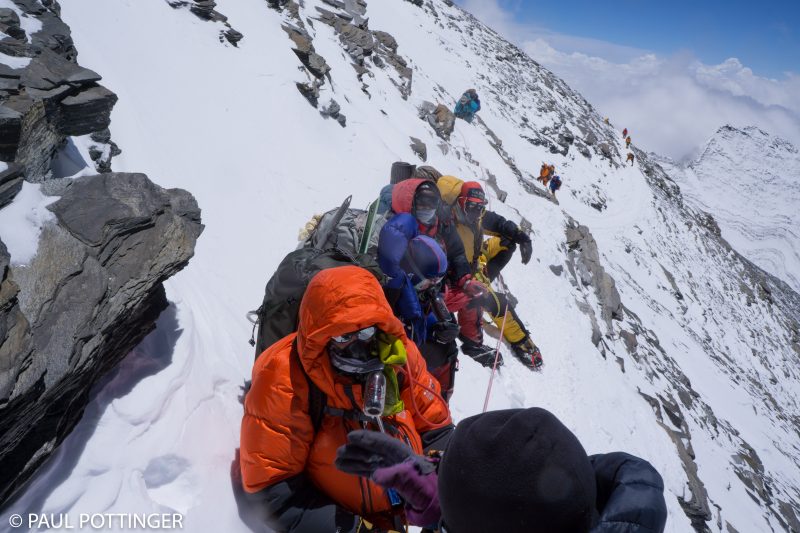
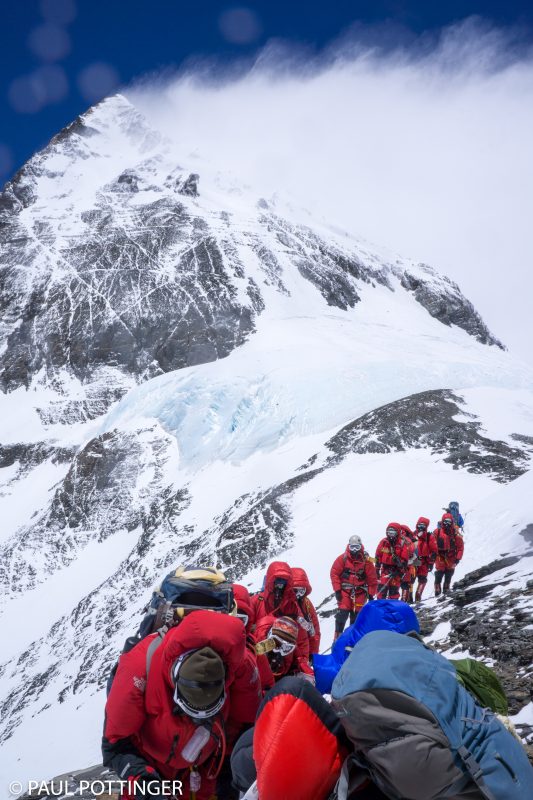
Suddenly we were in camp. I looked in vain for IMG’s Eureka tents… Where the hell are we? Our section of camp was at the far side of Camp 4. Those last few steps seemed to take forever, not a good sign considering the fact that we were on level ground.
Josh McDowell was acting as emcee and traffic director. I told him that I wanted to bunk with Cristiano so that I could perform neuro checks in the night. Initially he agreed, but then he took it back.
“Sorry, I totally screwed up. You are in the three-man over there.”
Three-man? “I’m happy to stay with Cristiano tonight.”
“Nope, you are over there.” Emily must be planning to stay with him and do the neuro checks herself. I agreed and carried my pack—which really was starting to feel heavy now—the last few steps towards a three-man tent in the distance, the last and final tent on Mt. Everest that day. Who the hell is staying all the way over here? I had absolutely no idea who would be in that tent. I was tired enough that it did not matter, but I wondered who my tent mates would be… until I saw Kim and Steven’s axes and crampons outside the tent. My friends… I allowed myself to smile. “Wasaaaaap!” I shouted through the mask.
“Paul! You made it! Hey buddy!” Their greeting was so great to hear. It dawned on me that they must have requested me for the three-man tent. My friends… my teammates. For the first time all day, I dared to relax a bit.
The tent door opened and I saw the Hessians in their lair, already unpacked and moved in nicely. “We saved you the best spot, right in the middle.”
“Nice. Thanks guys, let me get my sharps off and I’ll be right there.”
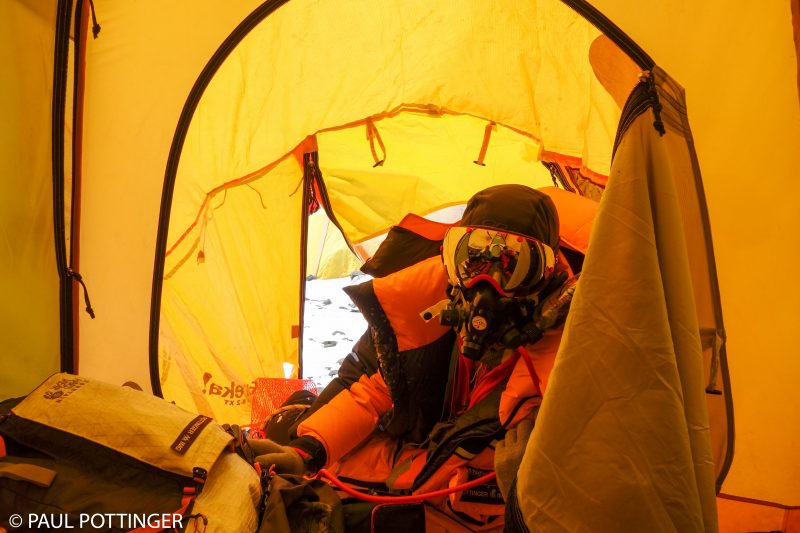
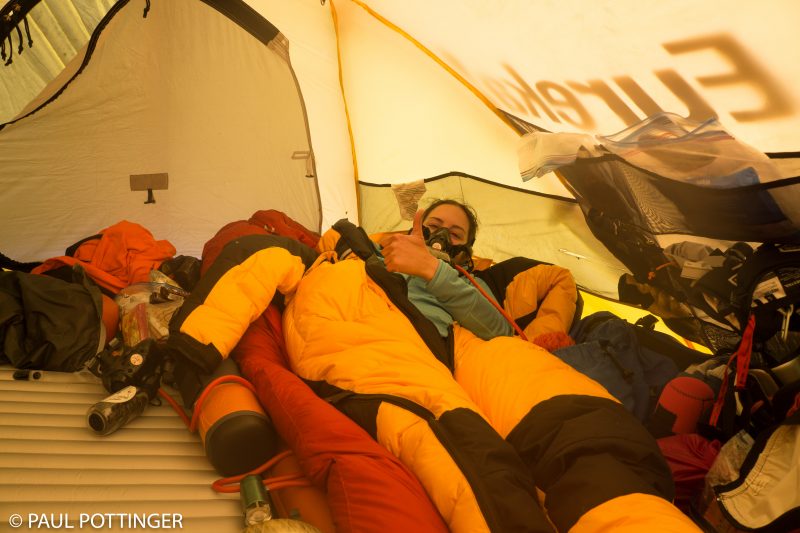
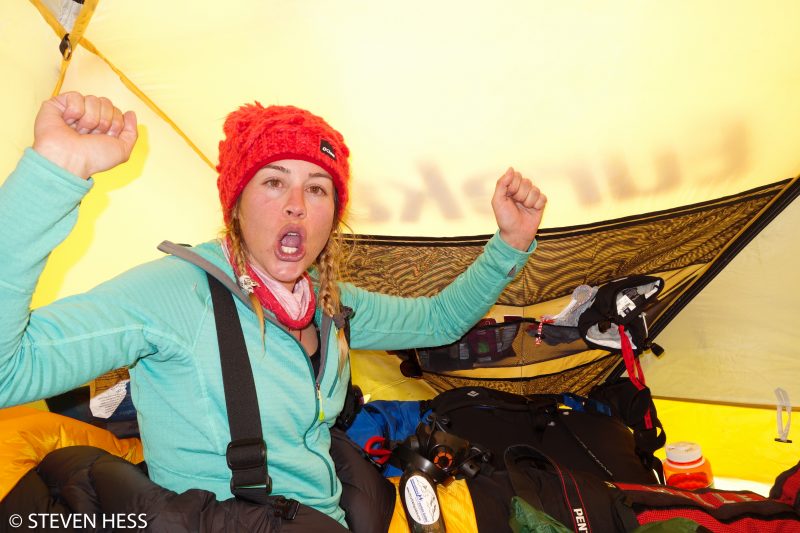
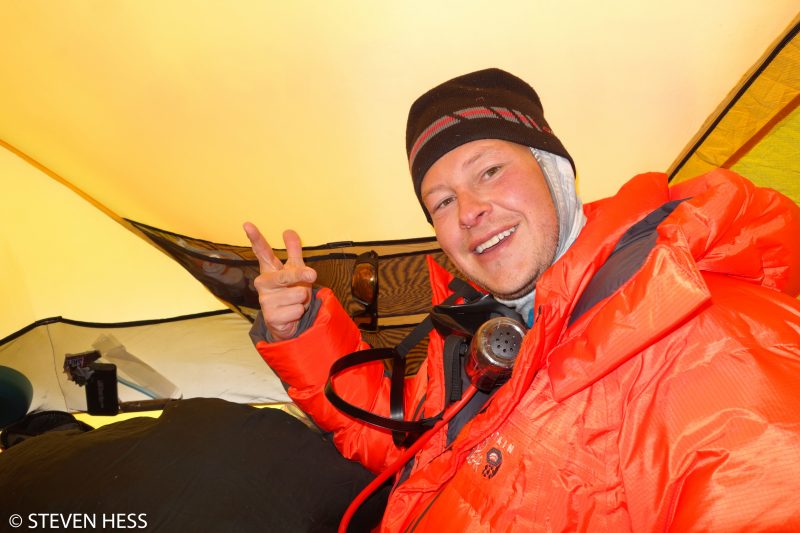
Steven and Kim helped me move in and get the thermarest inflated, a bit of a slow-motion marathon given how hard I was working to breathe up there. I got into my bag and got my kit organized. One pocket on the tent wall was for the stuff I would take the next day. My feet had been perfectly warm in the Olympus Mons that day. In fact, I had not installed the HotTronic warmers yet; I wanted my steps to be as light as possible, and so kept the inserts, cables, and batteries in my backpack. Now it was time to get the inserts into the liners and thread the cables up to the chest compartment of my suit, where the battery packs would live that night on our push towards the summit.
While I sorted through the gear, we talked about Cristiano, marveling at the miracle of his salvation on the Face, amazed that he had the gumption and strength to get right back and climb.
Almost as if on cue, Justin appeared in the vestibule, hunched over like a giant trying to enter a normal-sized house. He was making the rounds, ensuring that everyone was doing well and getting ready for the departure. Justin asked me what I thought about Cristiano climbing with us, and I told him it was amazing. He asked what I thought of the decision to allow him to come up, and I told him my medical opinion was that it was “fucking bullshit,” but clearly I had been wrong, and Emily was right.
We had a choice: Leave at 8 PM, 9 PM, or 10 PM. Two of our teammates had chosen to leave at 8 already, but that somehow seemed too early to me. Looking back now, in light of the traffic debacle that happened later that night, I wish I had chosen an 8 PM departure. But 9 PM seemed like the right way to go. Kim, Steven, and I agreed: 9 PM it is.
Justin asked for my regulator, so that he could rig our second oxygen bottle. I was confused. “This is my regulator,” I gestured to the setup I was breathing from.
“No, your other regulator.”
I saw it clearly: Lying on the floor of my tent in Camp 3, still attached to the cylinder I had shared with my tent mate. “Was I not supposed to leave it there?”
Justin just about flipped a gasket. “I told you to bring it with you, to give it to your Sherpa!”
I had absolutely no recollection of hearing that, from either him or Josh, the previous day. I can scarcely describe the depths of my horror when I realized I had made this mistake. True, I had a regulator on the bottle I was using at the moment, and swapping it out on the route above would be OK. But this was clearly NOT the plan our guides had in mind. Pre-rigging a second bottle at the South Col was preferable because it allowed us to look for subtle leaks in relative comfort and quiet, and to deal with them more easily. In fact, during prior expeditions, IMG guides had discovered that pouring hot water onto the metal mounting stem would prevent such leaks, for reasons unknown… Hot water was in scarce supply on the route, thus the urgency of pre-rigging the apparatus at Camp 4. Mind you, multiple bottle changes would happen up there, and some of these would have to involve swapping regulators… the point is that I had somehow missed an important instruction at Camp 3, and I felt terribly about it. No matter how many times I replayed the prior day’s briefing, I could not remember hearing this. What is wrong with my brain up here? What else have I missed?
Justin handled this with remarkable aplomb, given that it was a very unexpected setback. Later that afternoon a miracle occurred, and he located another regulator for my use. I will never know where that regulator came from, but it mattered not: all I could do was to thank him profusely and promise to not make that mistake again.
About an hour after I arrived at Camp 4, I headed outside briefly to take a leak, and to snap some photos. The first thing I realized was that going anywhere outside was very difficult without supplemental o’s. the next thing I found was that it really is a stunning place… alien and austere and scorched with solar radiation, a place to remember for the rest of my life. The wind was steady but not too strong, and the sun overhead blasted down through a clear blue sky onto the pure white snow-covered ground. I had always wondered how big it would be up here… Basketball court-sized? Football-field sized? In truth it was bigger than a football field, maybe a couple of them side by side. Plenty of room to roam around… if you were crazy or ill enough to try.
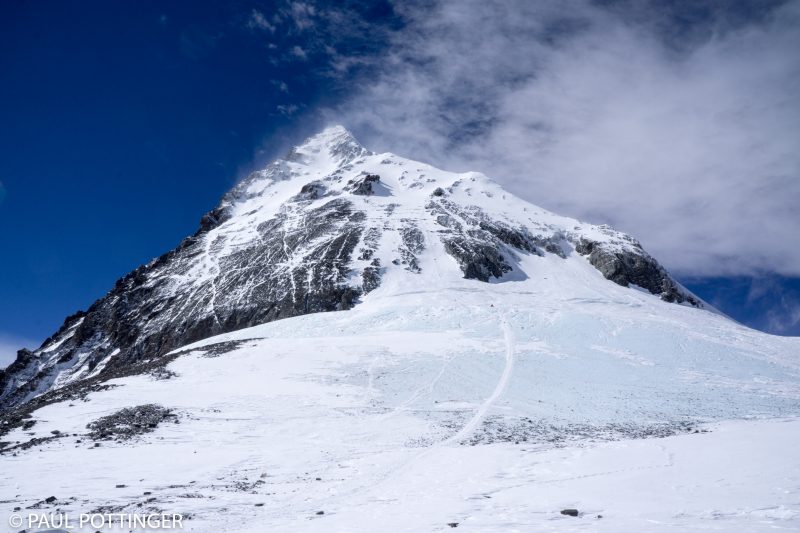
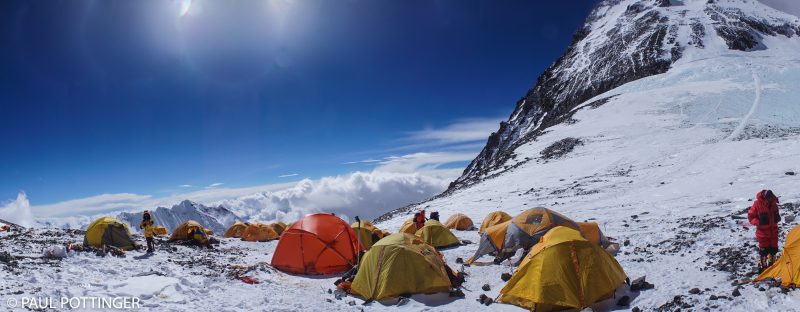
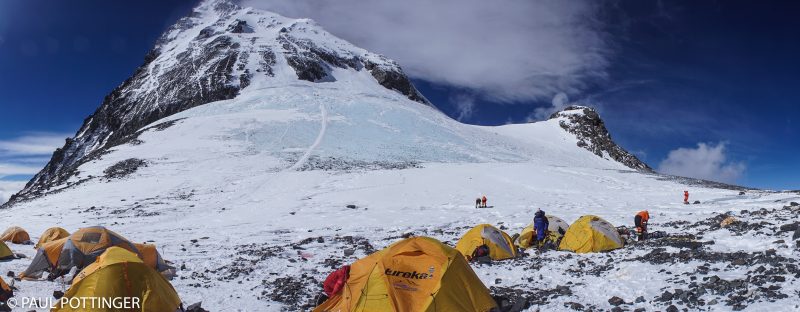
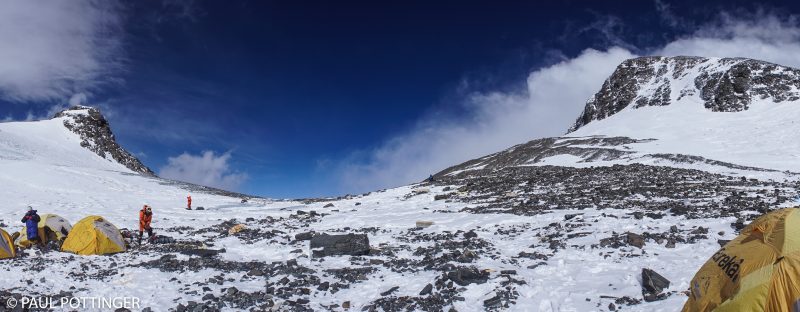
Back in the tent, I lost track of all the stuff I had set aside for the night’s departure. Where are my hand warmers? That fresh pair of socks I wanted to use? Those snack food baggies? I must have looked through the chaos of our tent floor for fifteen minutes, fighting off a rising sense of panic, before I remembered they were right there, a few inches from my head, in the tent wall pocket. Jeezus, if my head wasn’t screwed on up here….
One last task was to adjust our oxygen masks. Mine had bugged me a little on the way up, seemed a bit loose around the nose, leading to a bit of fogging in my goggles, and I wanted to be sure it would be tight enough that night. I tugged steadily on the upper silicone straps… until a tiny plastic hook on my head strap snapped off, brittle due to the extreme cold, falling to the floor. “Well that’s not good.”
“What?” asked Kim.
“I just broke the head fastener, damn thing snapped right off…. It’s OK, still seems to fasten alright so long as I keep it taught.” I did not want to believe that my summit bid could be ruined by the breaking of such a tiny piece of plastic—and, of course, it wasn’t. But, about 12 hours later, I would be cursing this little plastic hook, wishing that I had not broken it.
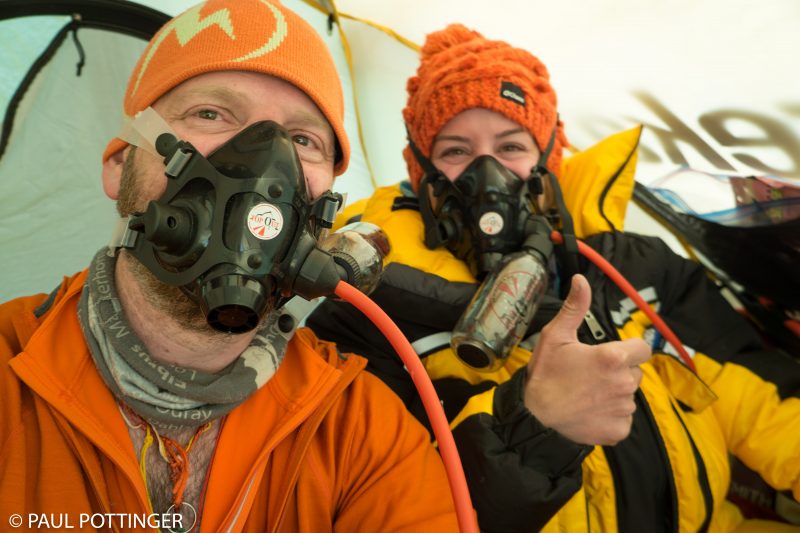
I wanted to talk with Julie. I needed to know that she was with me. My text to her at 2 PM (1:15 AM Seattle Time): “Hi Darling, I am at C4 sharing a tent with Hessians. Beautiful here. Love U.”
No reply.
An hour and a half later I tried again: “Hi dear. I leave here 9 PM, hope to summit in under 12 hrs, if weather and traffic good. Watch the Delorme. Doubt I can text or call from summit, will try.”
Still no reply, which is understandable given that it was 3 AM at home. But the time difference did not register for me.
I tried once more, a few minutes later: “Love you very much. Happy and also eager to come home to you very soon.” Did she even know that today was summit day? I felt completely isolated from everyone at home, a terrible feeling. This happens often during an expedition: I become convinced that my family does not miss me, or even realize I am gone. And why should they? Mountaineering is my thing, a supremely selfish hobby that pulls me away from them.
My heart leapt when the InReach chirped: “Love you!” That was all I needed to hear.
“You too!” I replied.
I was glad to lend the device to Steven so he could text his lovely new bride. It was tough for me to be away from Julie, and we had been together for 28 years. I could not imagine how crazy difficult this must have been for him, leaving only a couple weeks after getting hitched.
The cheese tortellini MRE went down like a thick, tasteless, slightly warm, nauseating goo. Every—last—morsel.
Just before tucking in I texted Jason in NYC: “That was no easy rest day… Easy terrain but 200 assholes on my line!! Crazy traffic. Sharing a tent with the Hessians.”
“HaHa! … [obscene joke expurgated] … Business time tho. Time for you to join the Summit Club. Take it home baby!!” It was 6 AM in for him, and Jason and Ali had a new baby. Back in the World I would never dream of texting someone at such an ungodly hour. But here I was oblivious of the time difference. In my mind, everyone back home was seeing what I was seeing, feeling what I was feeling… there was only one time zone, one reality, one existence: The South Col.
While I fussed with my kit, over and again, making sure everything was perfect with the camera gear, battery system, satellite tracker, provisions, water, clothing, and safety systems, Kim quietly crushed candy on her phone. Dammit, Atomic Girl… why is this so easy for you? And Steven… really? Are you really snoring up here? Maybe if I were their age this would be less painful for me, too.
We resolved to get at least a few hours of “sleep” before departing. We were all in our suits, and Kim and I lay under my -40 bag, like a huge eiderdown. It was plenty warm. When I closed my eyes, and tried to squeeze out the evening light filtering through the tent walls, I thought of the summit. After all this time, it’s right there, just outside the door. Waiting for me. I am an atheist, but Everest is holy to me, and being at the South Col was like the fulfillment of a sacred pilgrimage. That night, trying to sleep—hypoxic, exhausted, and anxious—something changed: the mountain took on a wicked persona. I came for the first time to see the summit as a siren, calling me to be dashed upon her rocks. Johnny Hollow’s lyrics haunted me:
Come a little bit closer
So I can see what you have done
I said come a little bit closer
Let me get a look at you
Don’t you know you want it, too?
Do I make you uneasy?
I bet you’d like to take a step back
I said do I make you uneasy?
I’ll follow even if you look back
Don’t you know you want it, too?
Don’t you know you want it, too?
Come a little bit closer…
Come a little bit closer…
And I thought, You can’t intimidate me, you evil bitch. There’s no way I’m turning back now.
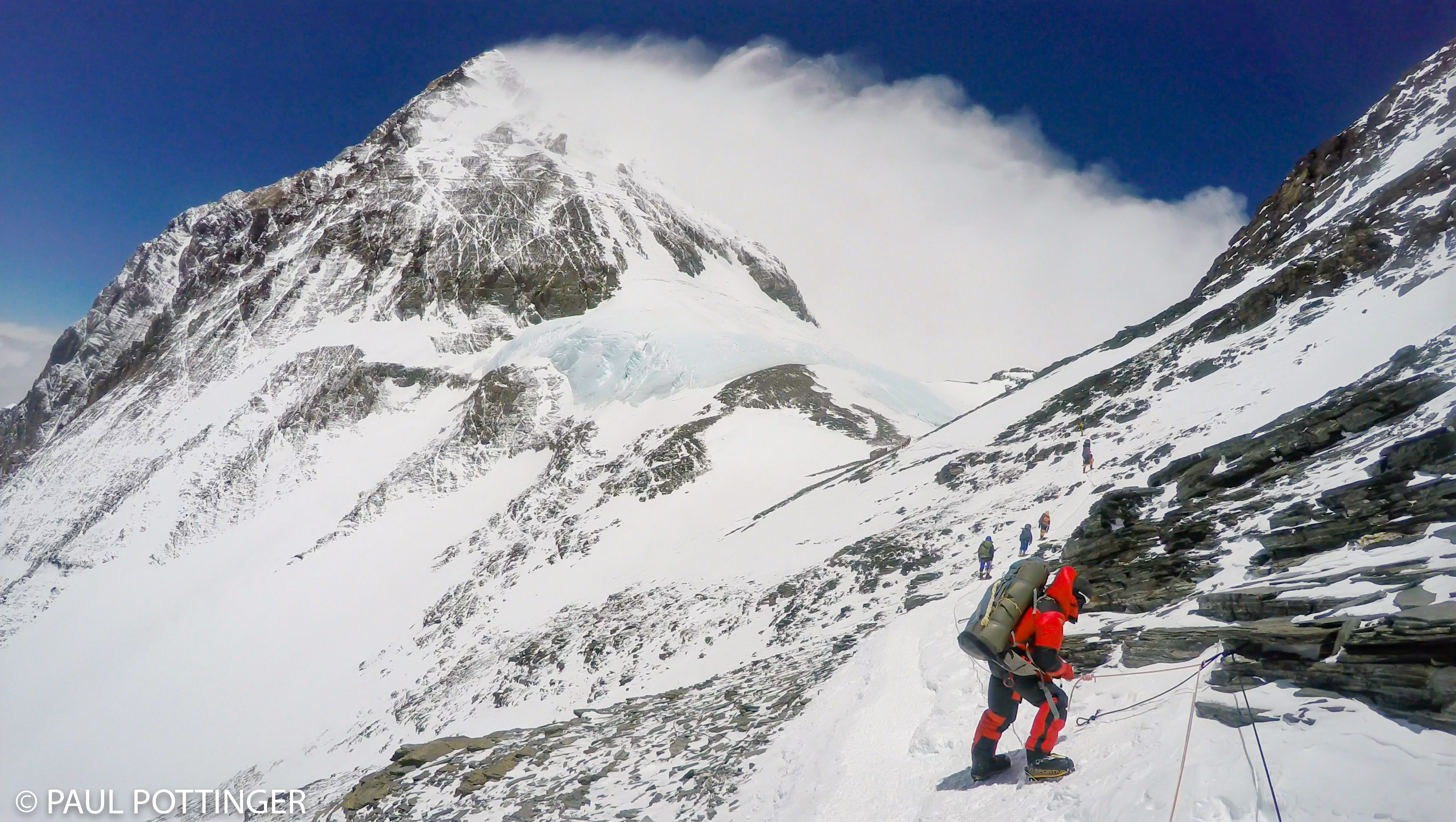

This is a spellbinding and, in places, heart-stopping account. A masterful bit of storytelling. What an amazing adventure! Thank the universe you returned safely home! Love you!!
Thanks mom, love you!
Really wonderful account Paul! Fantastic.
Thanks JBL!
Hi Paul,
We have all been waiting with baited breath for this installment and you certainly haven’t disaappointed ! Wow, not only the best account I have ever read of climbing Everest, but also some of the best photos – they show in detail the nitty gritty of what is really involved. Your writing is also brilliant – truly the next best thing to being there. I now know why it took so long to put this blog together…… simply a fabulous account.
Can’t wait for the summit day and the descent.
Many congratulations, not only an outstanding climb, but an amazing blog.
Thanks so much Kevin for your kind words!
Captivating story. Enjoying this adventure through your words and pictures.
Thank you so much Rosa.
Thank you so much for sharing your adventure with us. I stumbled across your blog very early in your journey and followed you all the way, including tracking your GPS on summit day. I celebrated too when I saw that you were back down off the summit.
I’m not likely to ever climb anything higher than the peaks in New York’s Adirondack Mountains, but I have truly enjoyed climbing virtually with you through your gorgeous pictures and gripping narrative.
That is such a nice message Christine, thank you. I am glad this is of interest to you, and I appreciate your support, especially on summit day!
Any chance of you posting your summit narrative before the first anniversary? I would love to read more!
I agree with Christine, we are all here waiting for the next chapter of this amazing journey. Best wishes and keep us updated also on your future projects!
Thinking of you as you take trip number 2. Stay safe!
A tale well-told. And what a tale it is, Paul. Thank you for taking the time to record it so well, share your own experiences and perspective, and give us some great reading! And video. Bravissimo!
Thanks Susi for all your support and good cheer!
Great writing and photos, I feel as if I were there with you! One thing I am missing is – how cold was it? I have read many write ups on Everest and they all say something like “we woke up to a frigid/cold morning”. I have lived all my life in South Dakota and Minnesota and cold to us means something different than to those in Seattle or Florida. I would like to see temperatures and wind speeds mentioned more often, I can calculate the wind chills.
Thank you Steve. I did not carry a thermometer or anamometer… but, it was bone dry, cold in the shade (I would guess -20F) and hot in the sun (circa 90F). Usual high elevation conditions.
Once again amazing footage and a great realistic account of climbing Everest. Thank you for taking us on this adventure with you!
Thank you Jennifer for these nice words, they are greatly appreciated.
Two questions formed in my mind after viewing the photos of the conga lines on the steep face in your last post:
1. Has anyone stepped on the lines with their sharp crampons cutting the line and leaving everyone exposed?
2. Could a catastrophic domino effect happen if someone slips and falls? I could see one person falling, tipping over another person, then another, causing many people to be pulled over to the point it would exceed the capacity of the anchor points. At that point the entire conga line could go sliding down the mountain.
Thanks for your questions Steve.
1. Yes, the lines do suffer crampon wounds on occasion, and that’s not good. UV light, freeze-thaw, and rock chafing are all hazards to the kernmantle and the core underneath. Thus, new lines are fixed each season. I have never heard of a crampon wound causing an accident, thankfully.
2. Yes, we worry about the reliability of the anchors for sure, especially with so many people on each line. It is a hazard that the route-fixing team is very aware of, leading them to make each one as “bomb-proof” as possible. The anchors I saw on the upper mountain really truly were stunningly reliable; in the icefall, it is a different matter, due to constant melting of the seracs.
I love, love, love reading about this. What a great story you tell! (And, of course, that it’s fact, not fiction, just makes it all the more amazing!)
Thanks so much Lavinia, you are very kind.
Wonderful, what a webpage it is! This weblog presents valuable information to
us, keep it up.
p2,
What a great job you’ve done documenting your amazing climb! Looking forward to your next installment.
Ken
(Nice DB quote too!)
Thanks much Ken!
I’m still here with you. Unbelievable story and photos. Am anxiously awaiting the next installment. I forward this to many friends who have also been following this adventure. Thank you for sharing your journey.
Yvonne Sage (Roger Pomainville’s sister)
Thank you so much Yvonne. More to come soon…
Great blog and great story! I Can’t wait for the next part.
Greatings from Italy!
Thank you so much.
Wonderful story, truly captivating! read it end-to-end. When is the next part coming out 🙂 I can’t want wait to read getting to the summit on your own words?
Thanks so much Yamil. Working on the next installment now….
As above, looking forward to the rest of your posts and the videos. Some of the best I’ve read and seen. Thanks.
Thank you Josh. More updates to come soon!
Paul, Heading to Everest in two months. I would love to speak with you live. Can you email me please.
Regards,
Drew
Paul – When’s the summit segment??? Can’t wait
Paul, Am still here waiting for the final. Know you are busy. Will check back from time to time. Yvonne Sage
Great account Paul. See you up high again some time.
Fraser from Australia
Fraser, thanks! Great climbing with you… and great to hear from you buddy.
stumbled upon this blog from Facebook of all places. Facebook suggested a page called happy summits: An agency out of Tuscon Arizona who had reposted your video. So I investigated and soon discovered that you went with IMG, not ‘Happy Summits’ who have seemed to appropriated your video.
Anyways, I found your video to be so much more informative than all of the documentaries on Everest combined. Thank goodness for GoPro. I think those GoPro’s have changed the game on Everest with those fabulous photos. And your blog! Well, better than all the books I’ve read about Everest climbing. Why read about boring dry history when a graphic description of climbing the Lotse face is right there. Well done.
Hi Chris, thanks for your nice post. You are correct, I am not associated with that other website, but glad you found me nonetheless. More of this blog on the way soon….